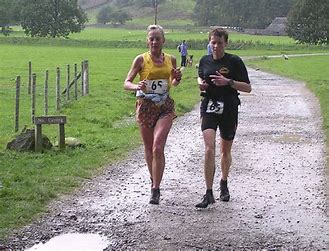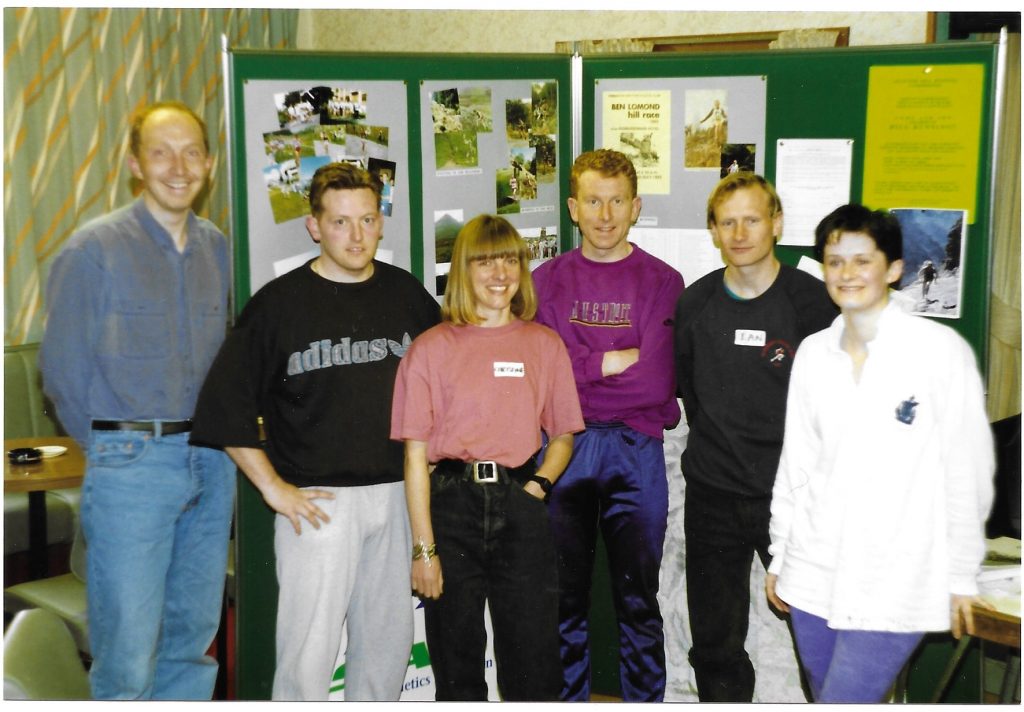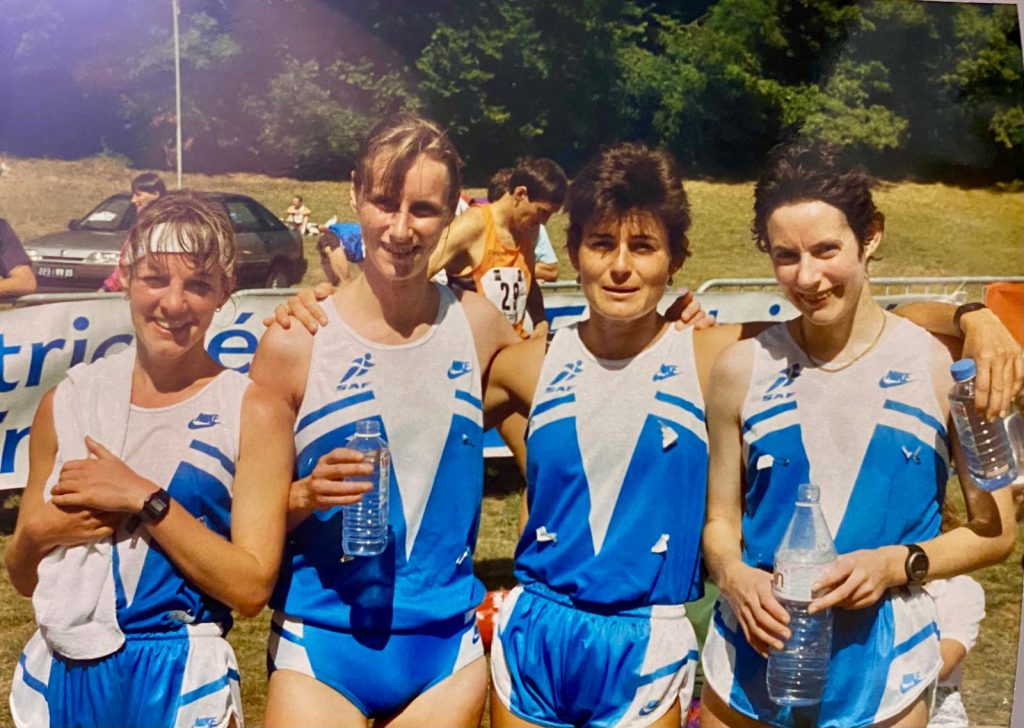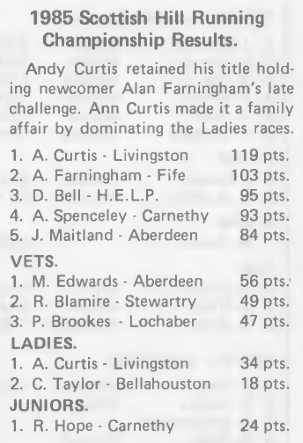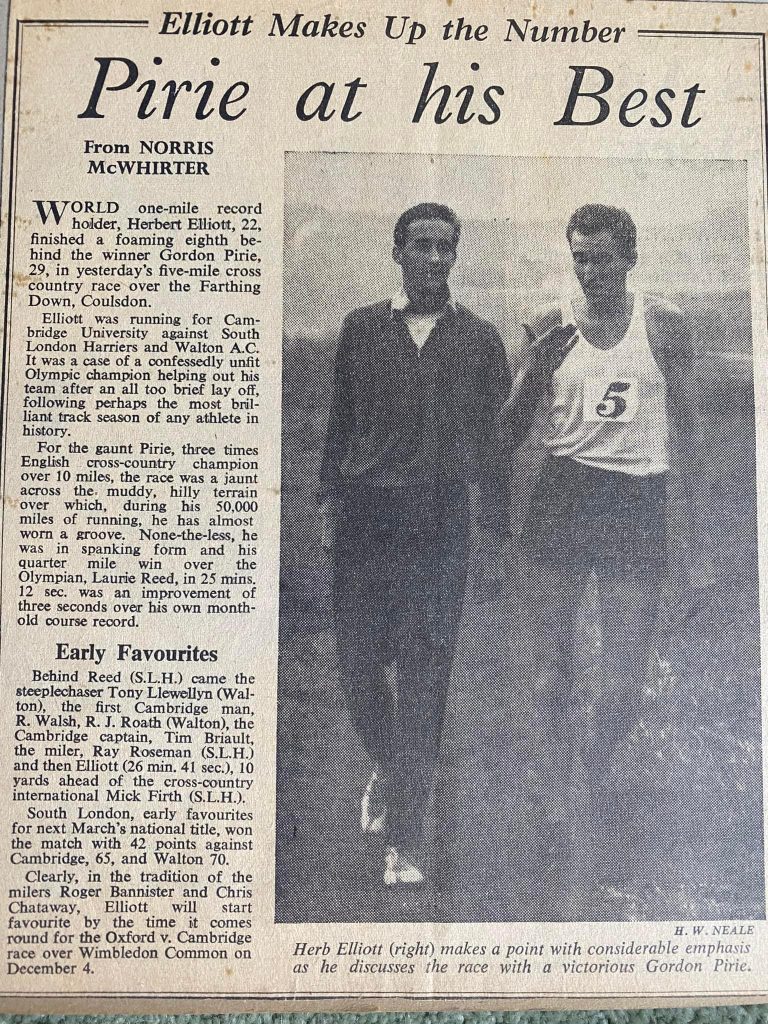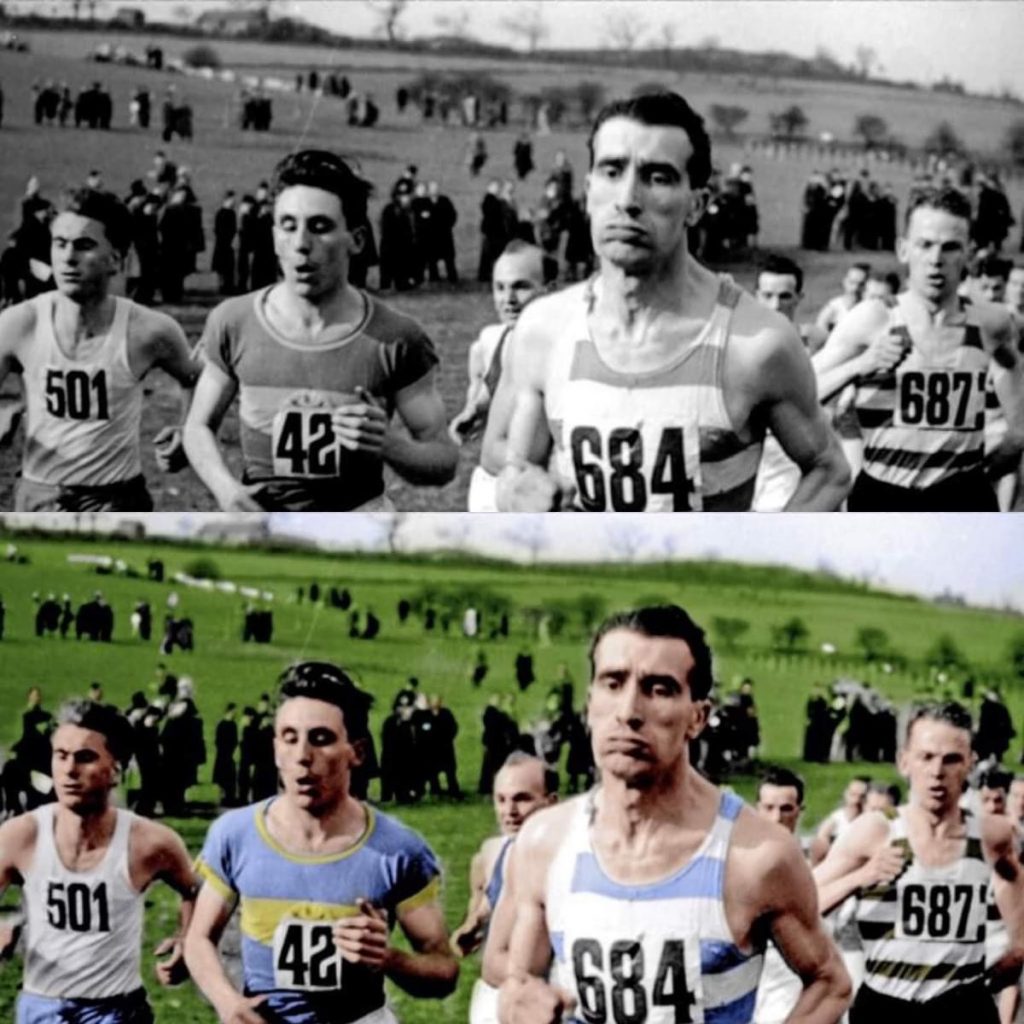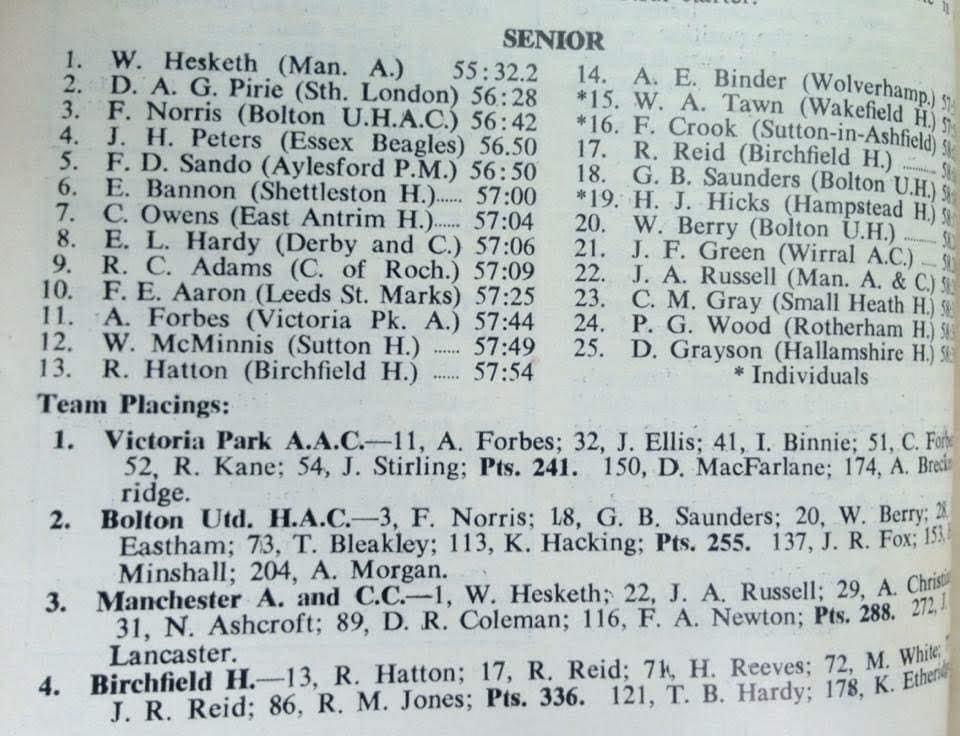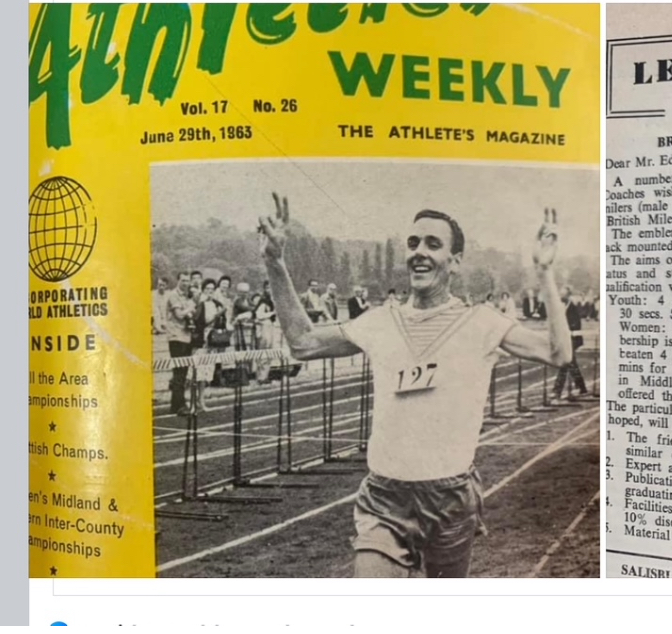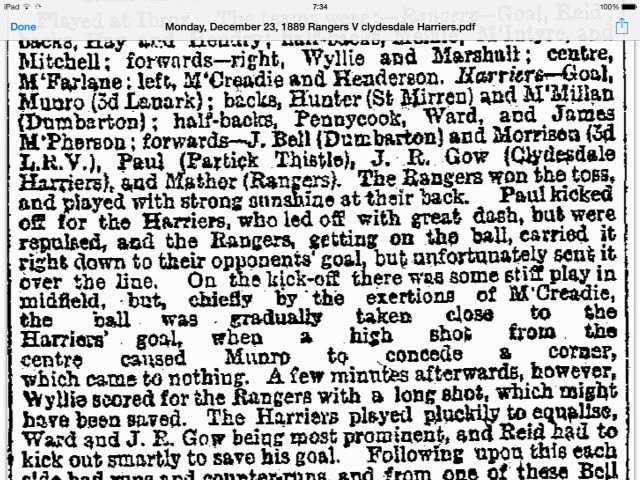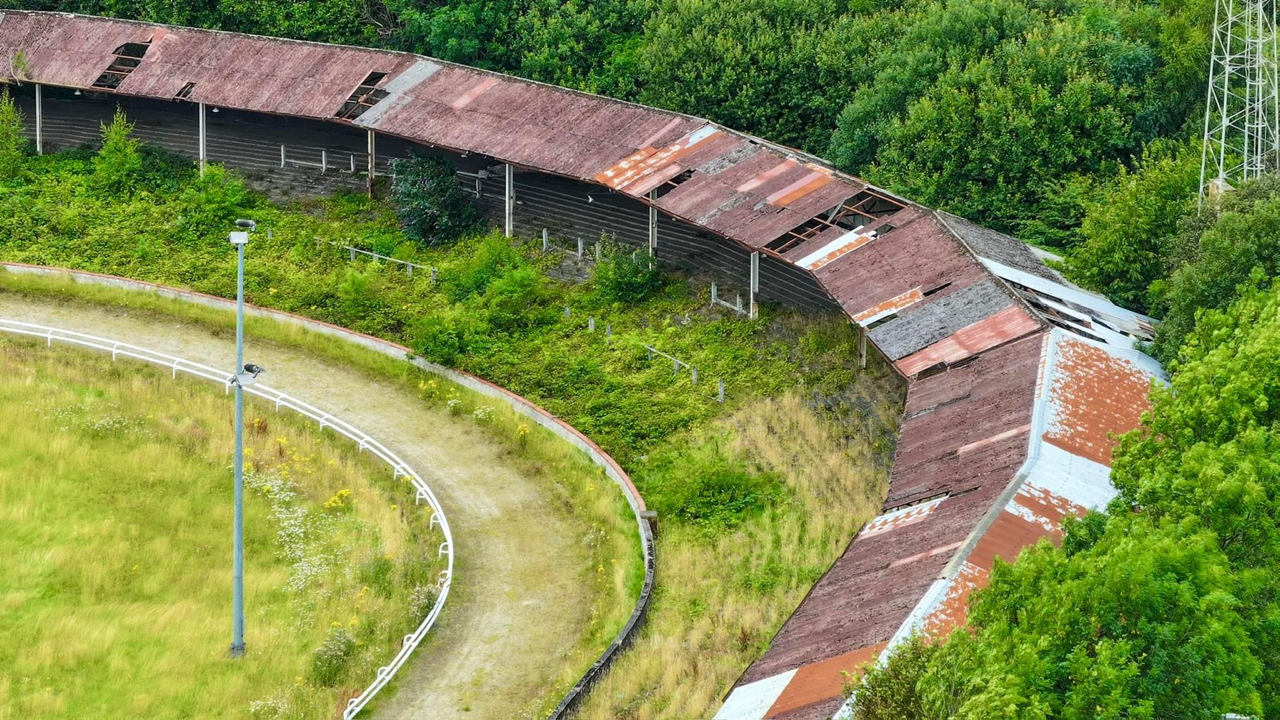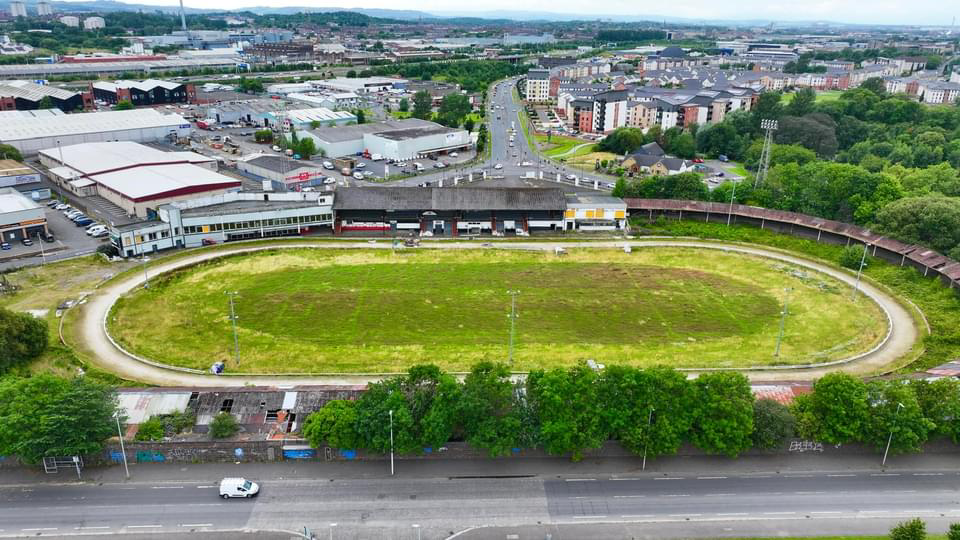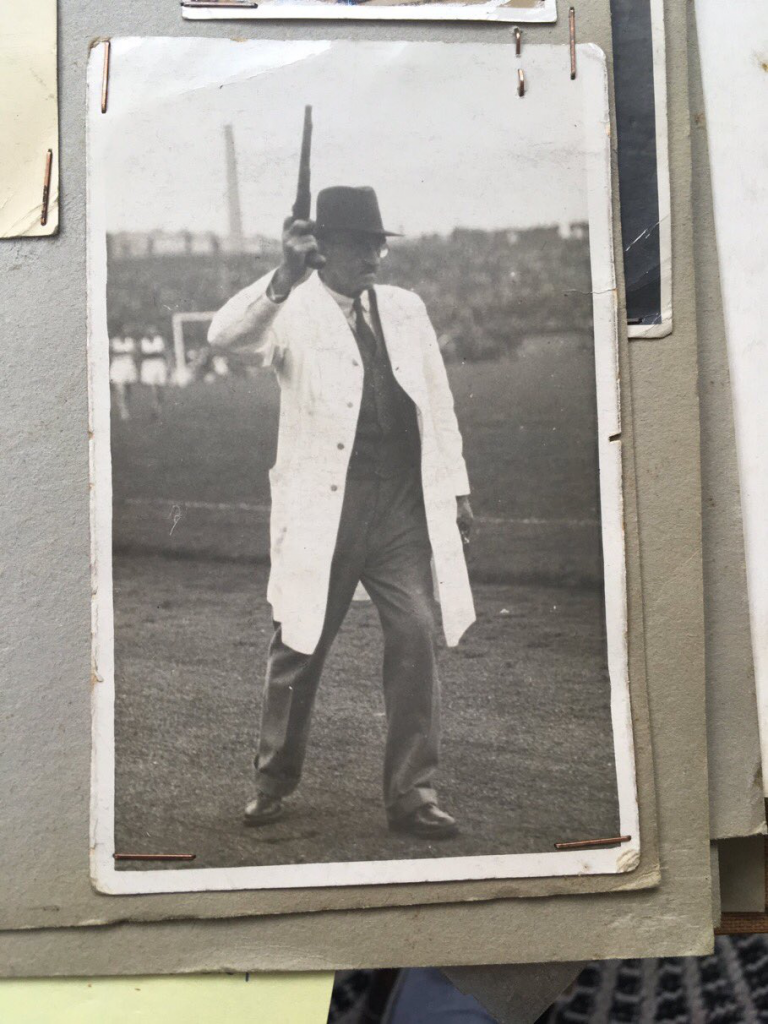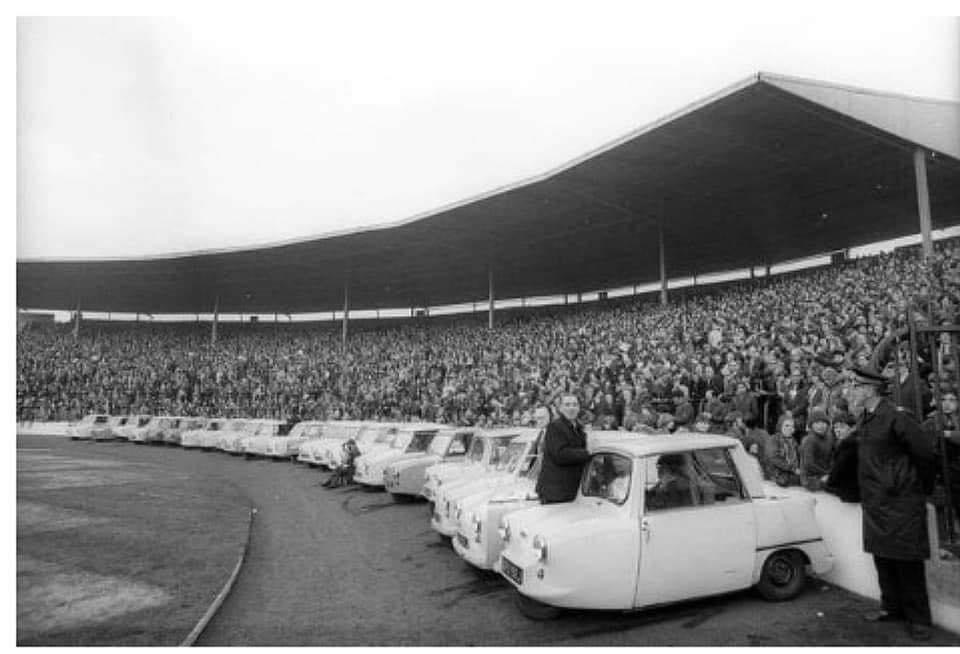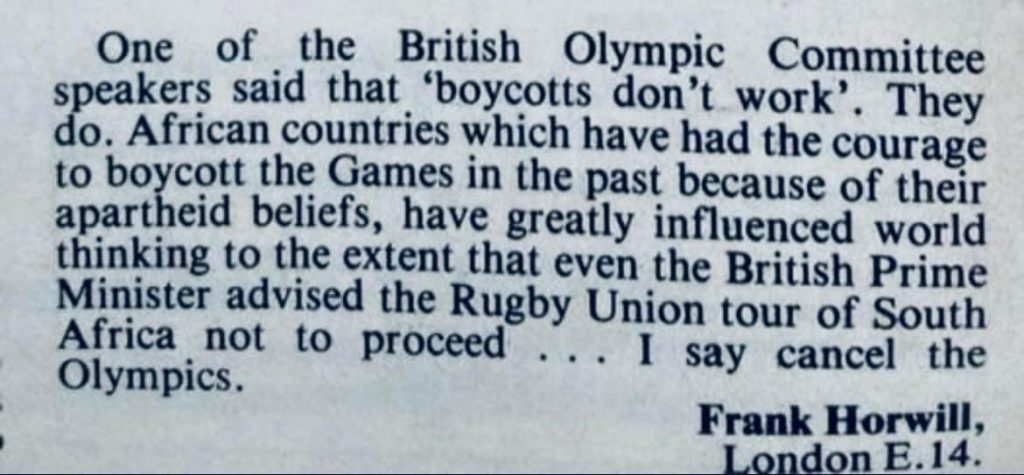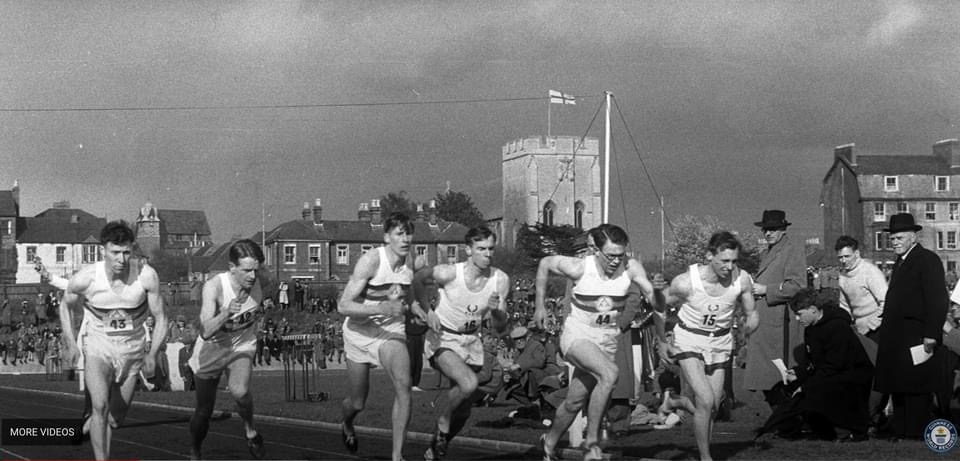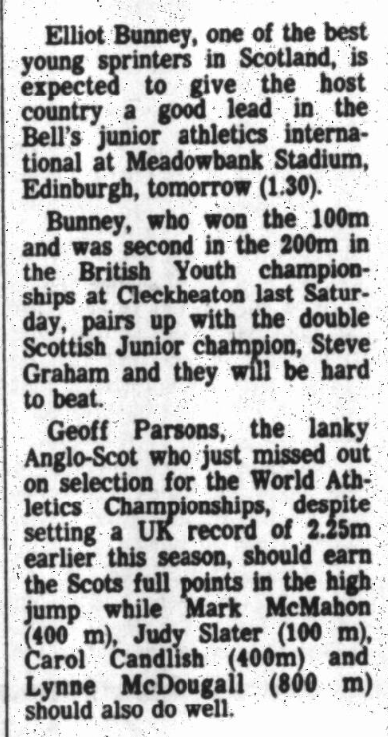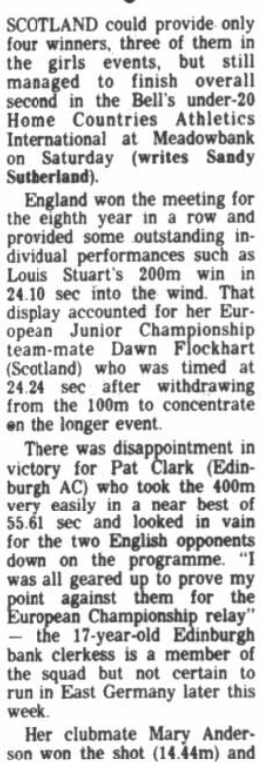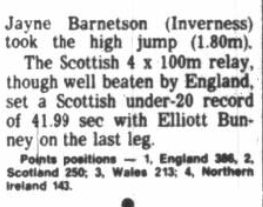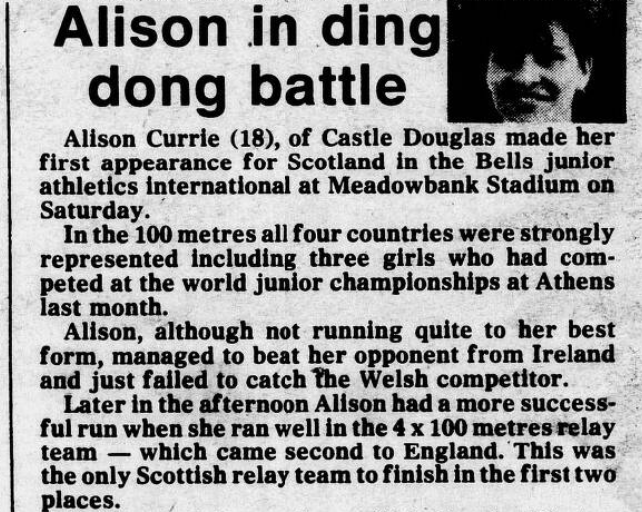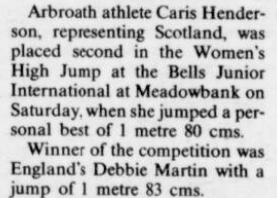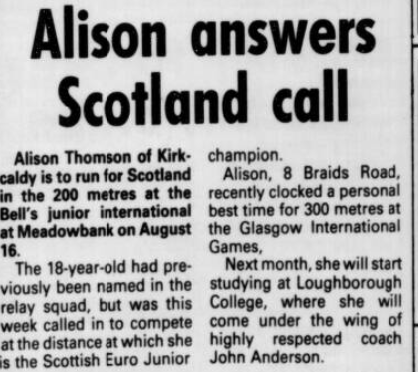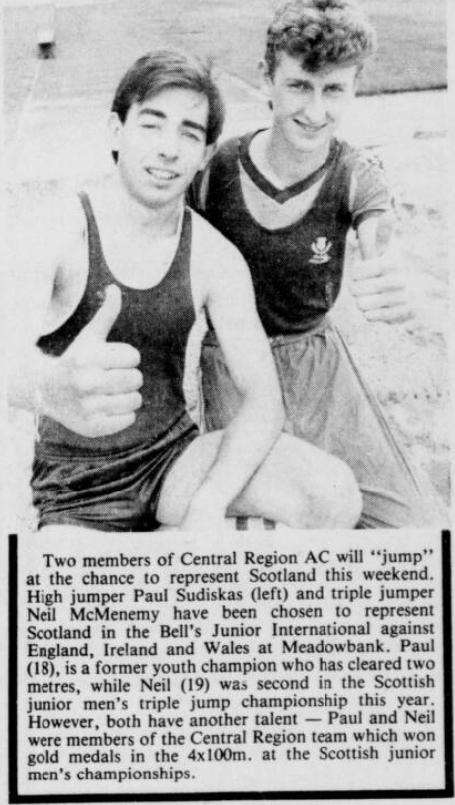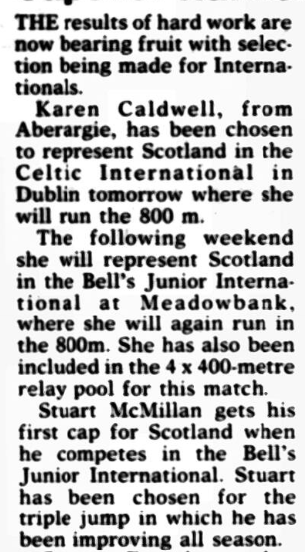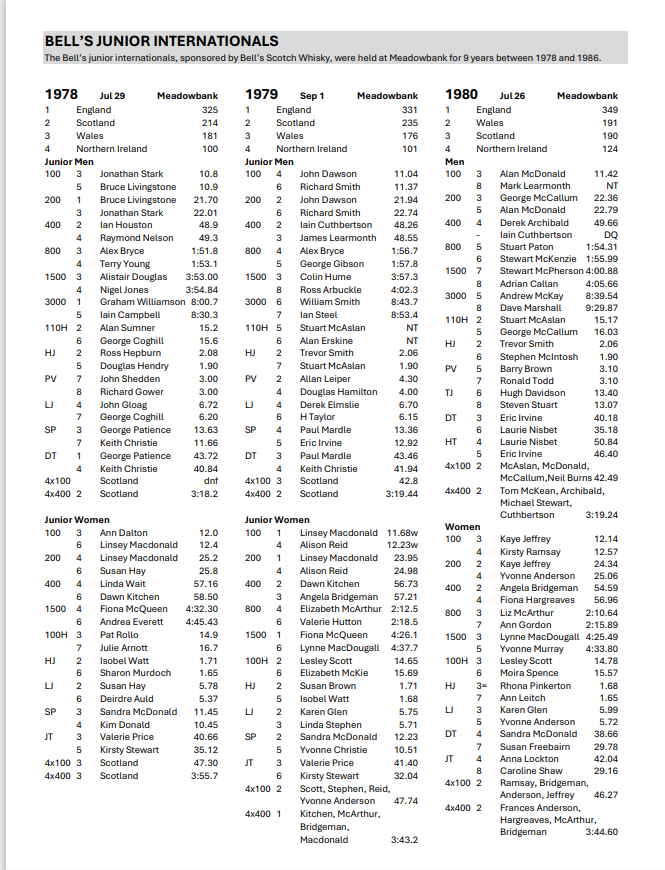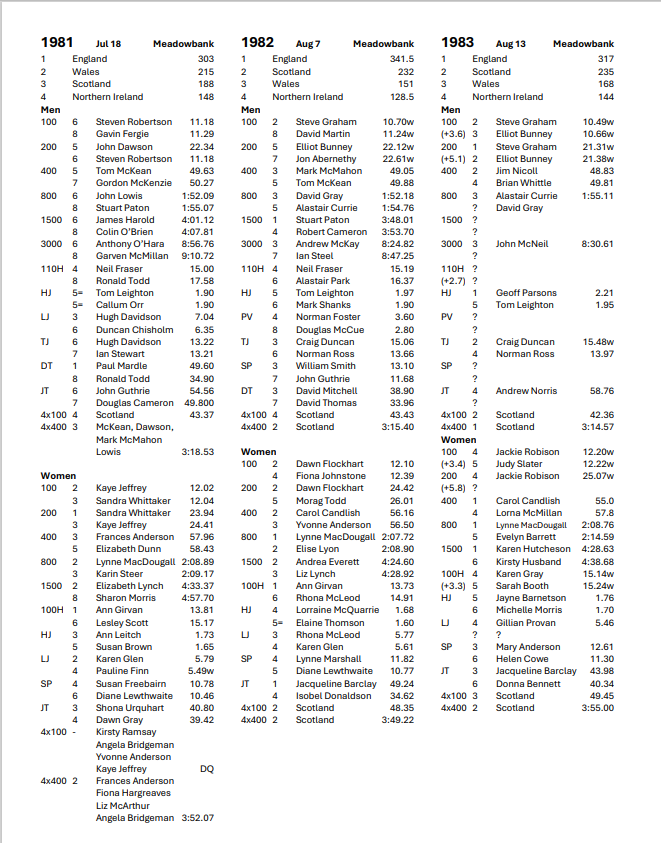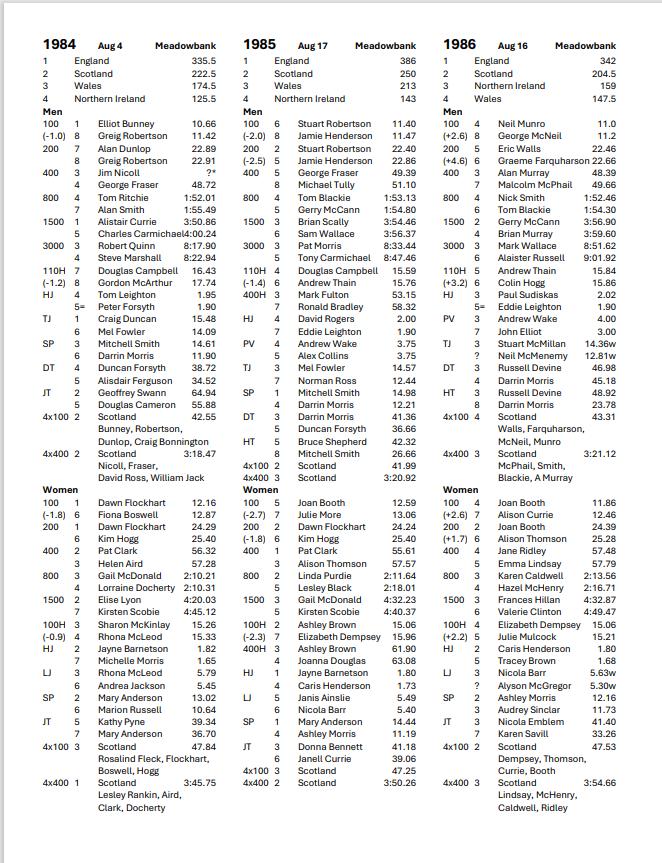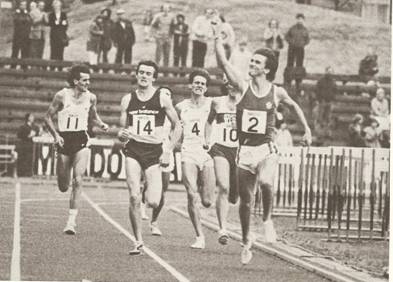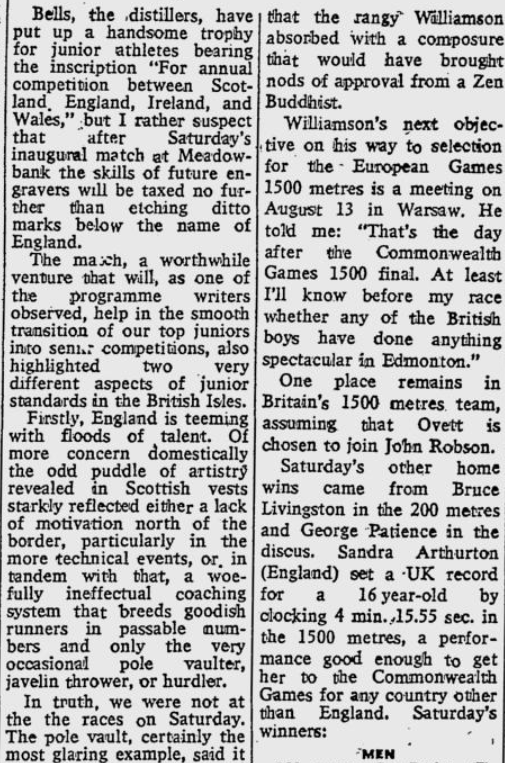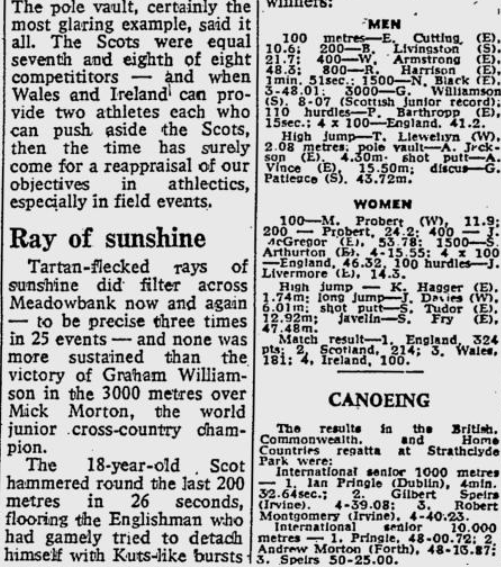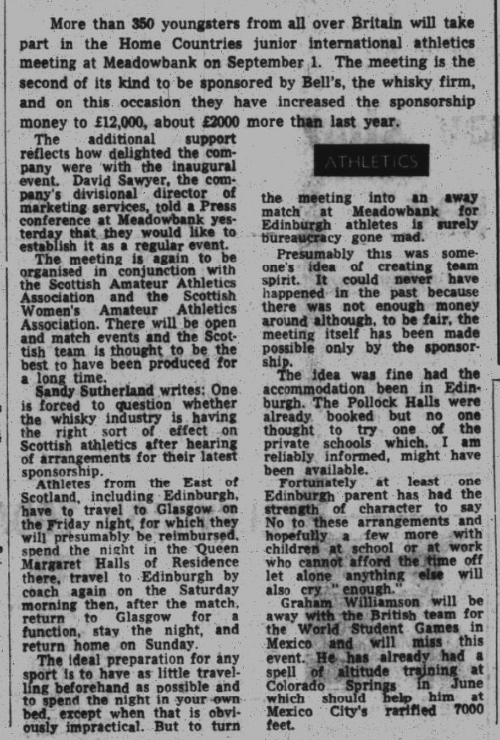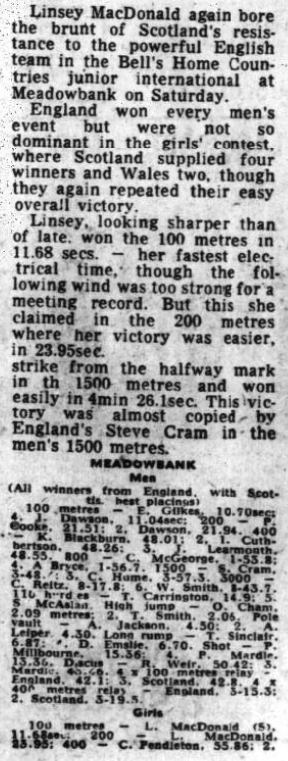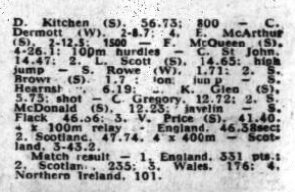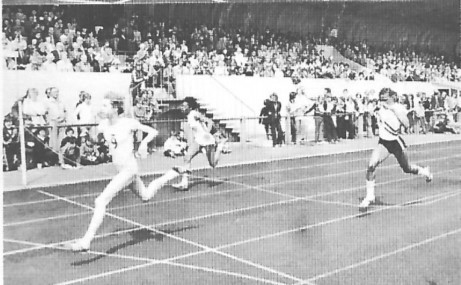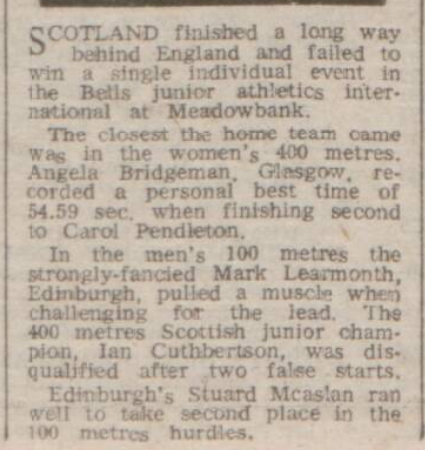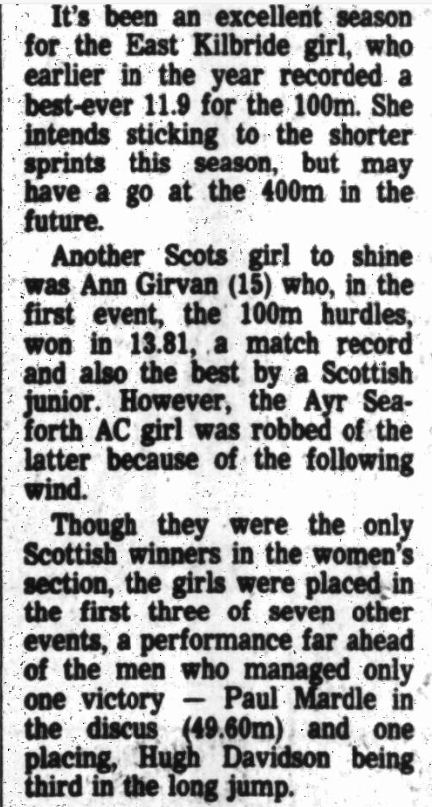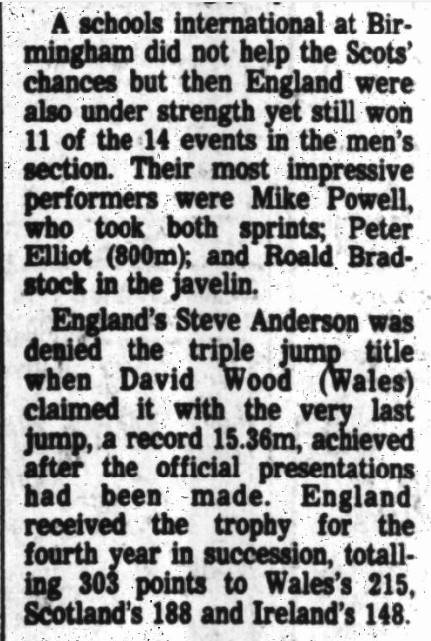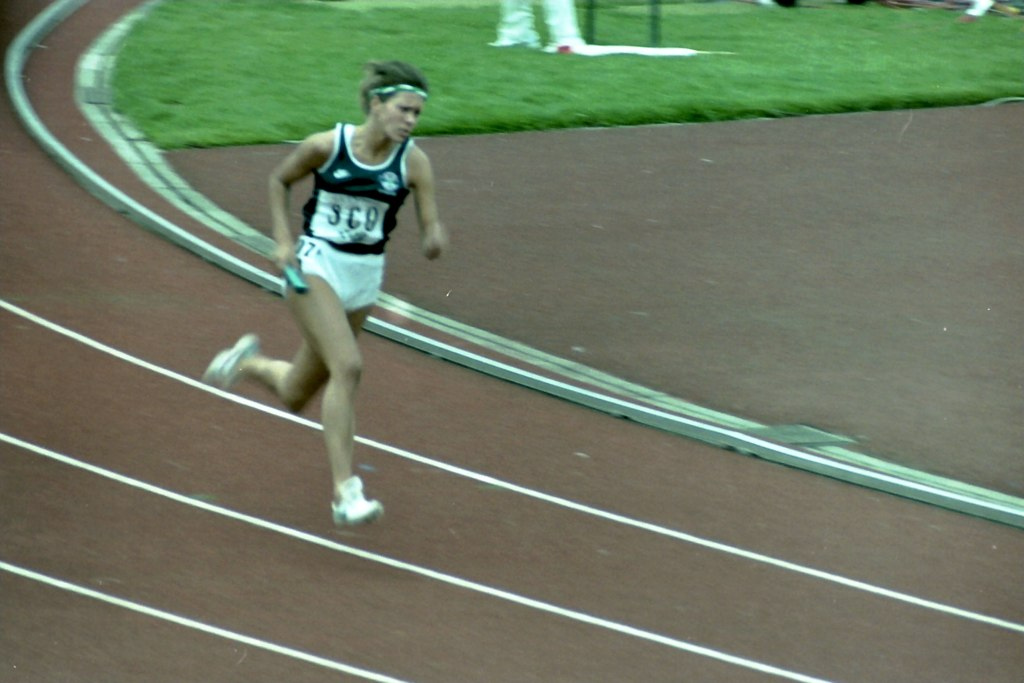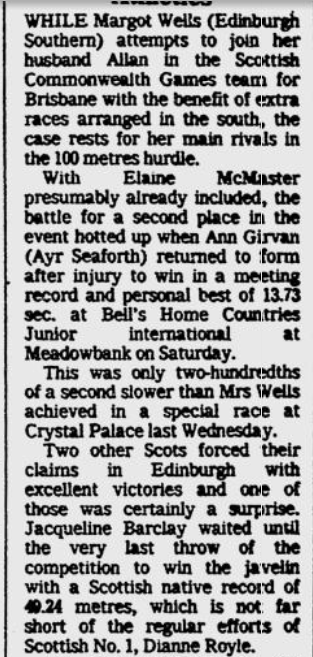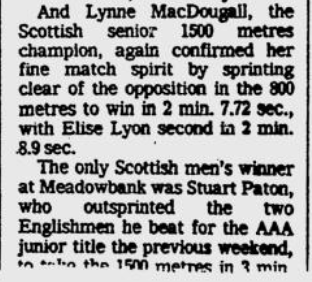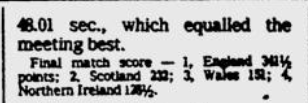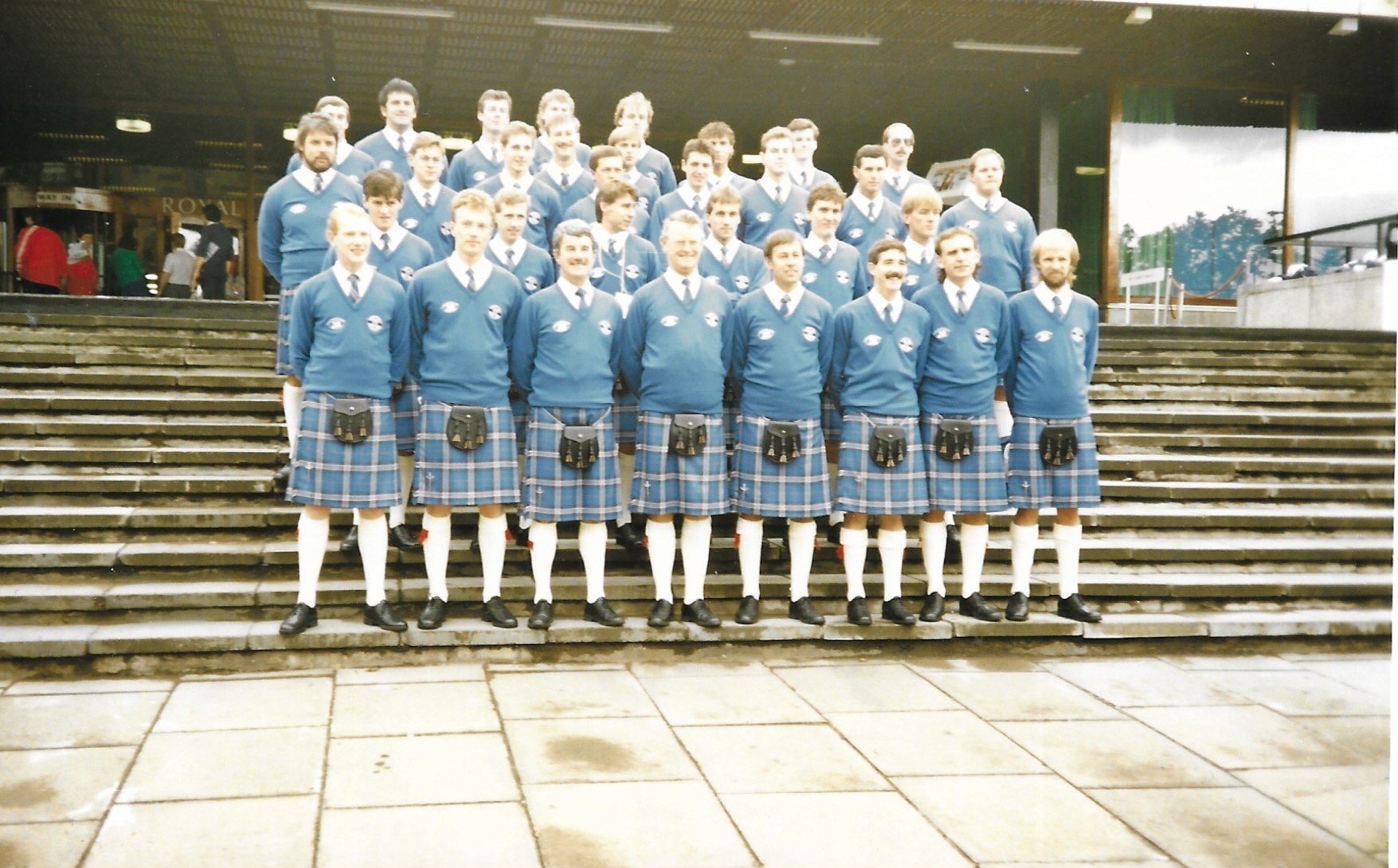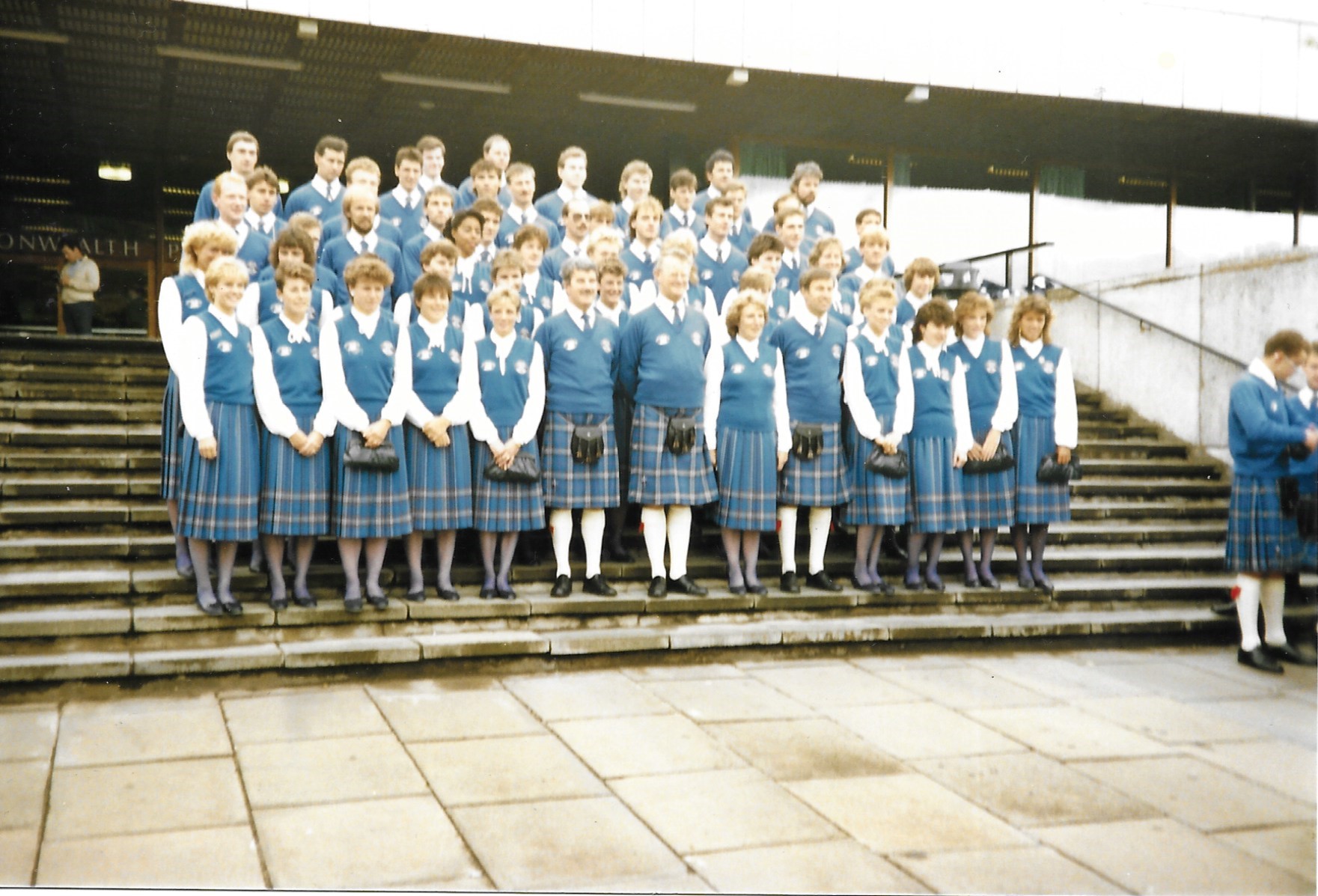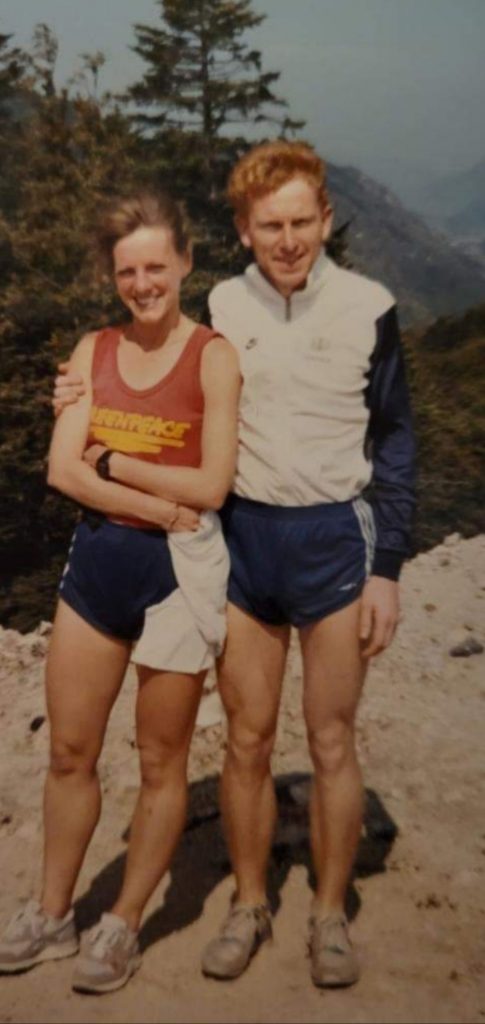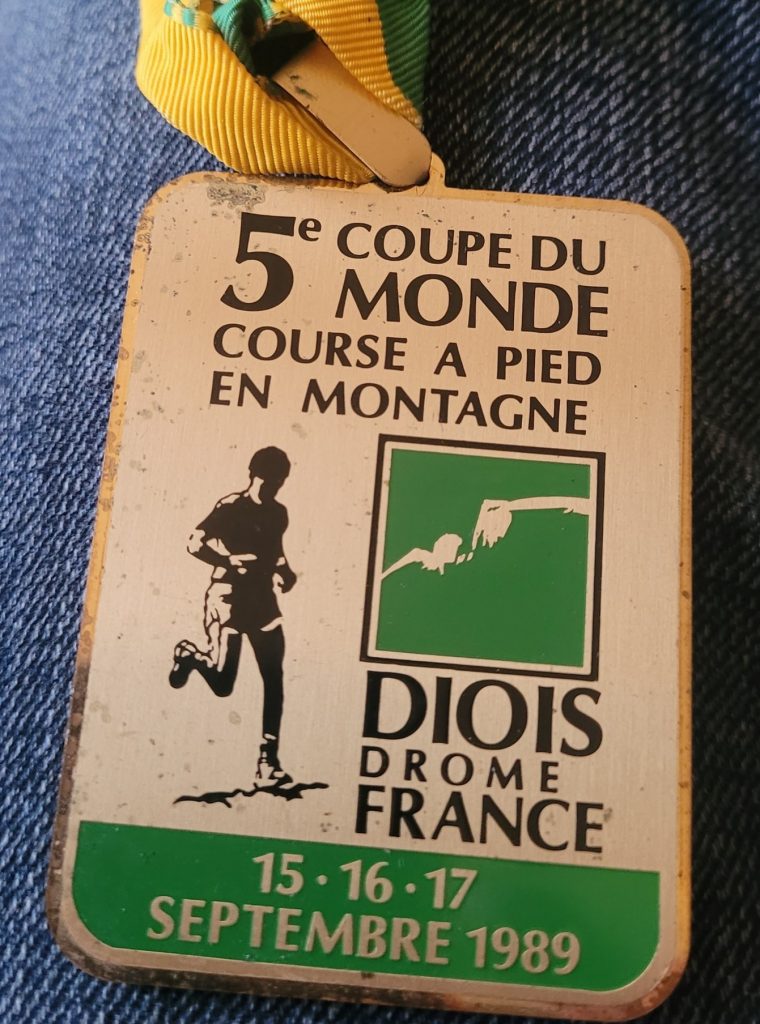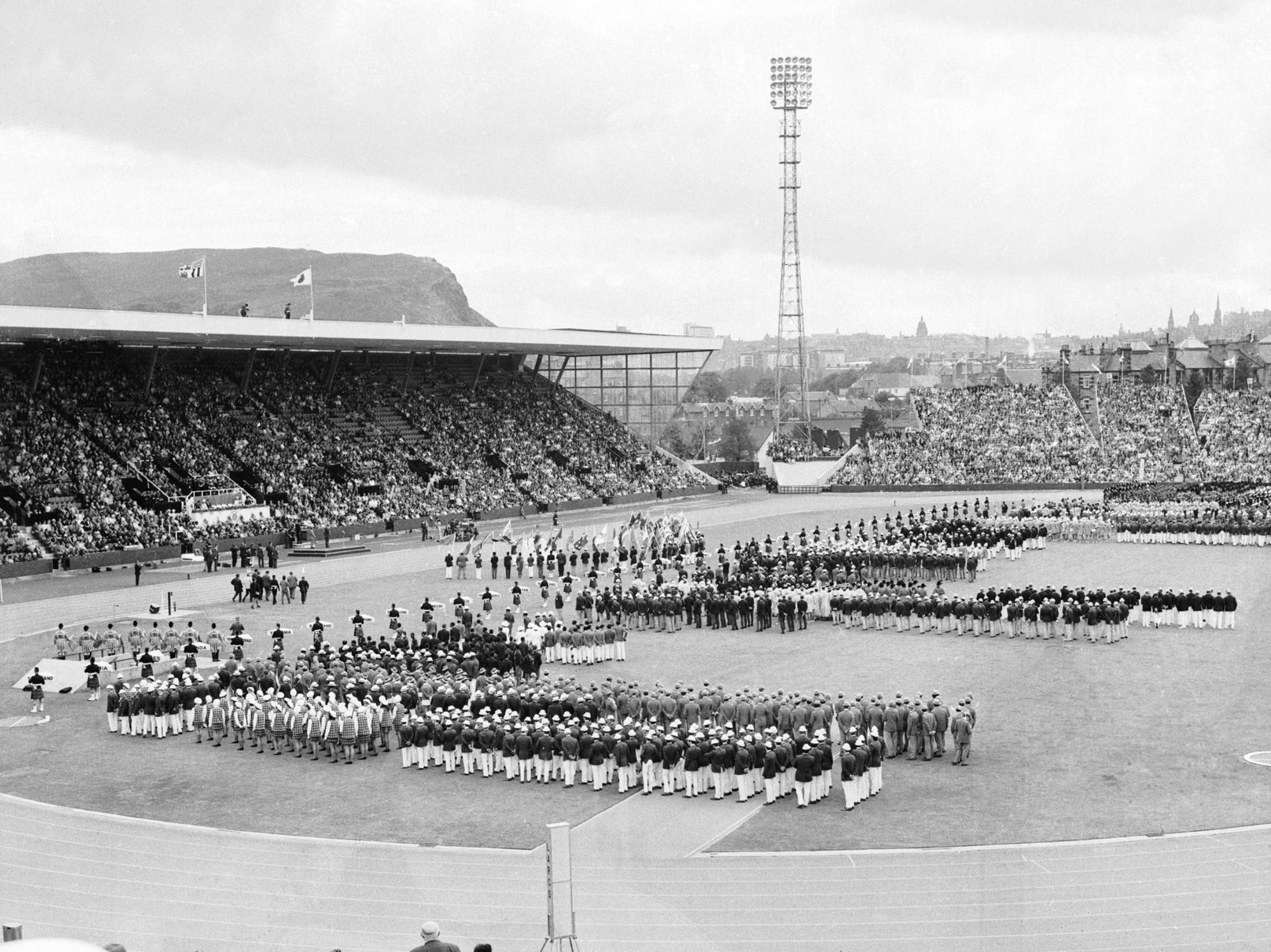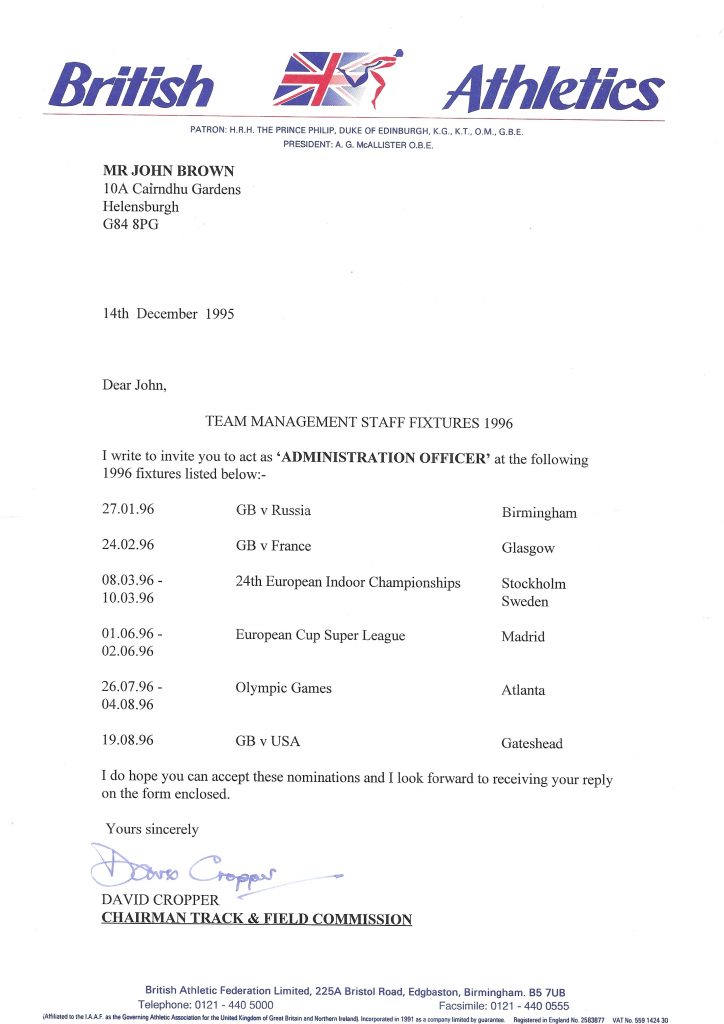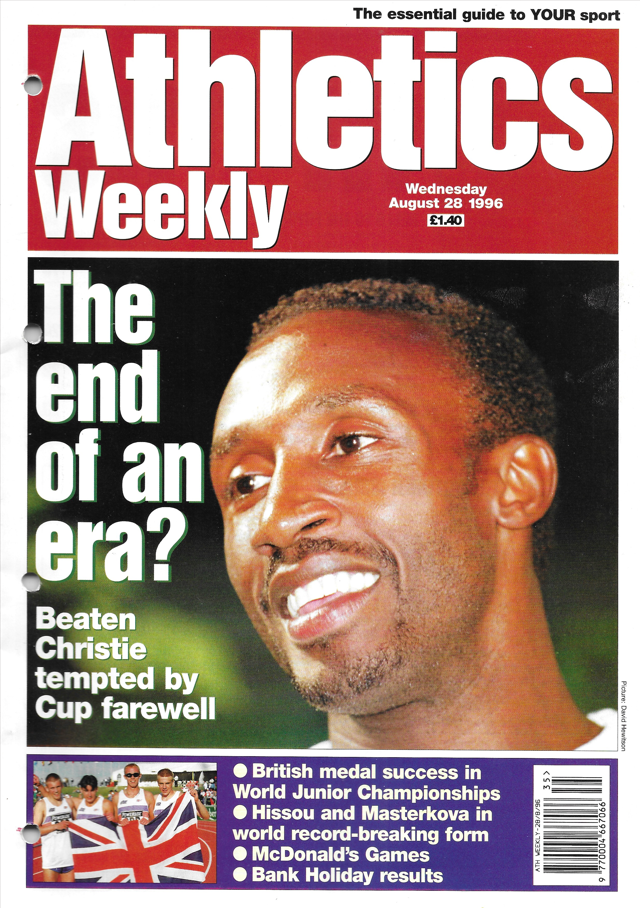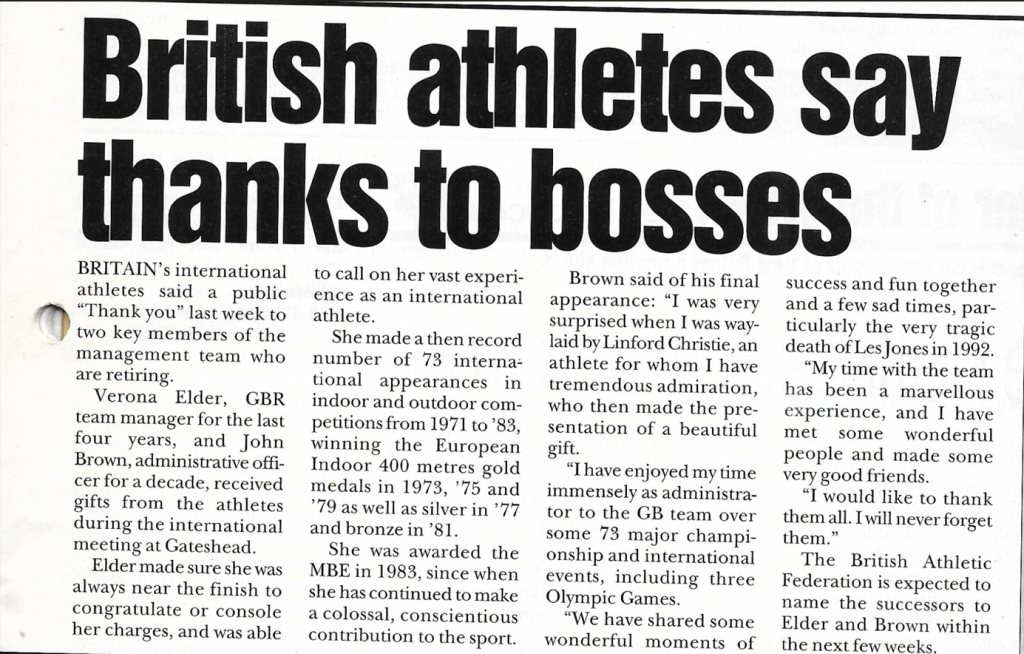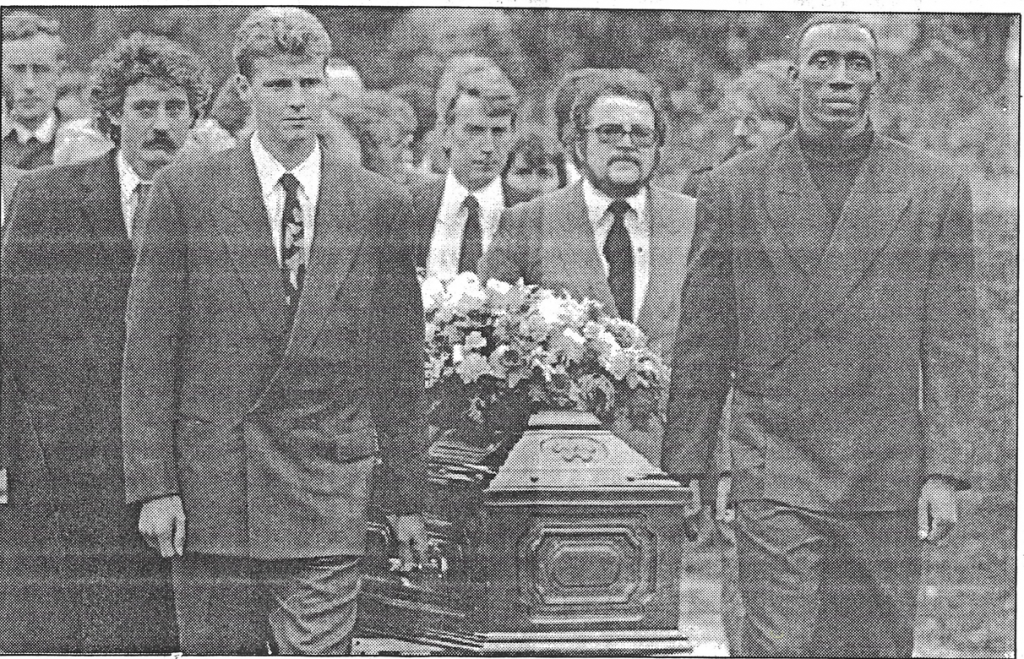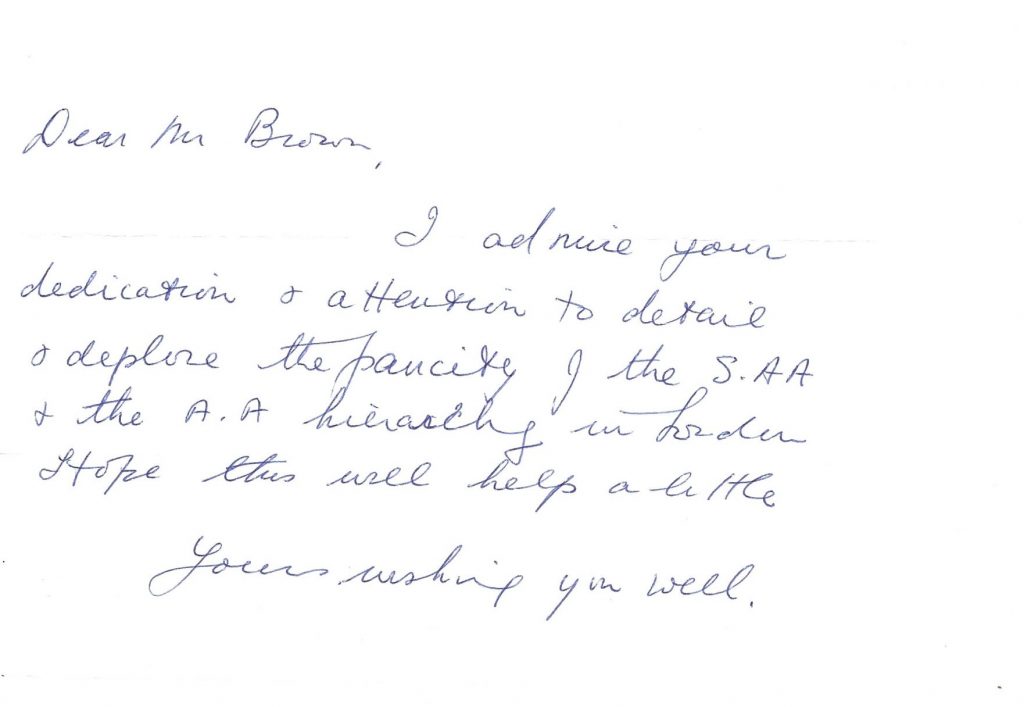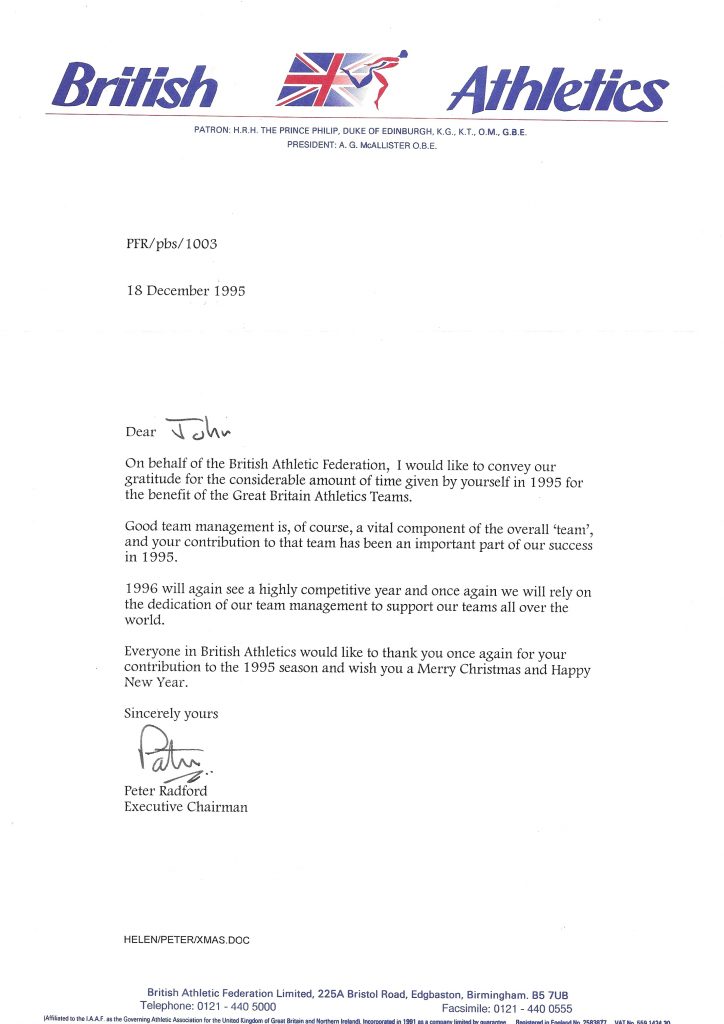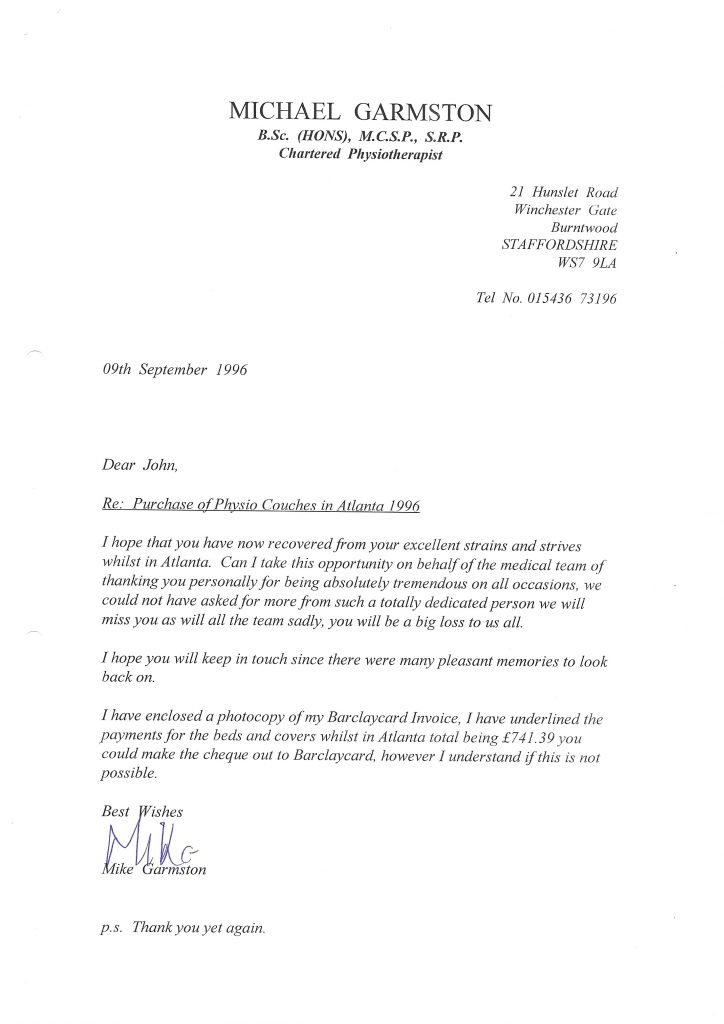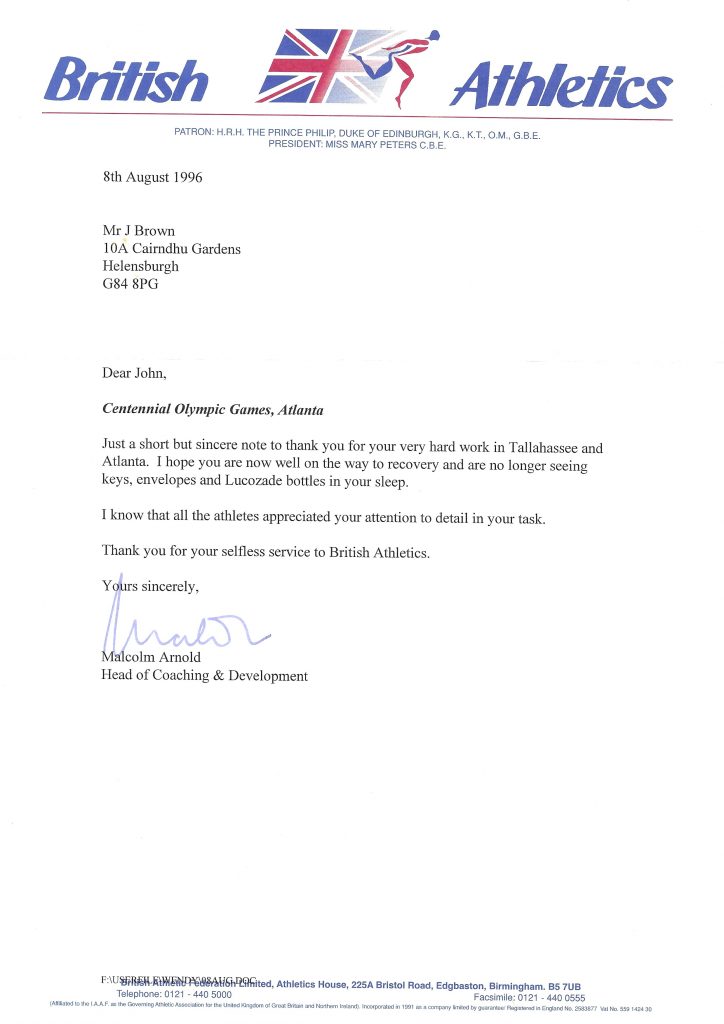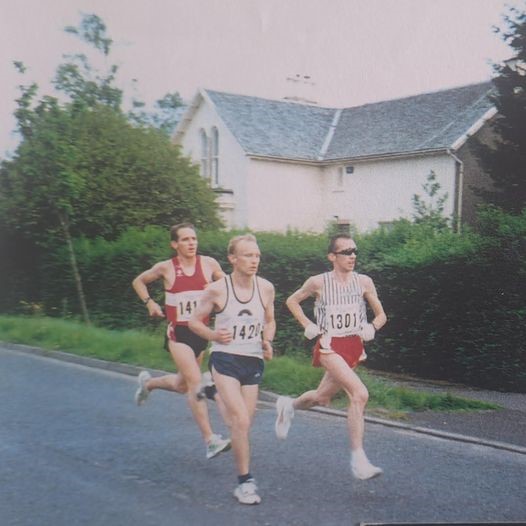
Ian racing Tommy Murray and Alex Robertson
Ian Murphy arrived on the endurance running scene as a fully fledged senior athlete. There was no coming through the age groups, or of a couple of years finishing down the field and working his way through the ranks. He kept fit by cycling, hill walking and by the activities undertaken in his job as a personal development officer. After arriving on the scene, Ian ran very well indeed on all surfaces. He was an immensely talented athlete whose career was blighted by injury and illness although this did not prevent some quite superb performances. Although he ran well on the road and track, he excelled on the hills and in some of the wildest country races that Scotland could offer. We asked him for his own comments in reply to the questionnaire.
Name: Ian Murphy
Club: Clydesdale Harriers
Date of Birth: 1st November 1964
Occupation: Fire Fighter
How did you get into the sport initially: Through my friend Andy Dytch.
Personal Bests: All my records!
Has any individual or group had a marked effect on your attitude to the sport and/or your performances? Pat Bonner, Jim Shields, Christine Menhennet.
What exactly did you get out of the sport: Adventure, Achievement, Fitness, Pleasure, Challenge, Friendship.
Can you describe your general attitude to the sport? Take it or leave it, in a nice way!
What was the toughest event you’ve ever taken part in? West Highland Way – length and weather.
What do you consider your best ever performance? My first win – the IBM 10 Miles Road Race.
… and your worst? Running for Snowdon. Got heat stroke.
What goals did you have that were never achieved? Winning the West Highland Way.
Can you give some details of your training? Running hard/hills/hiking.
Further to the remarks about how he got into the sport, Ian has credited Andy Dytch and Pat Bonner with his start but speaks elsewhere of “The Great Jim Shields his CMV – Coach Mentor and Valet”! He thanks Christine for that.
As he says above, Ian was introduced to the sport in the first place by his friend Andy Dytch, an experienced and talented hill runner. They often walked in the country and hills at Loch Ard where Andy had a trail that he used as a time trial and, like all runners with a personal course that they use to judge their fitness, had a personal best for the course that he was quite proud of. Ian reckoned that he could beat it – and ran round and did indeed beat it. Andy then, without hesitation, got him into hill running and racing.
The first race appearance noted was in February 1986 when he ran in the Carnethy 5 hill race on a very snowy afternoon and finished 46th. On that occasion there were four Clydesdale Harriers running including Andy Dytch and Jim Shields but Ian was listed in the programme as “I Murphy, Unattached – Clydebank’. Ian also took part in the Karrimor International Mountain Marathon over two days with Gordon Pryde. This a fierce challenge in which the runners run in pairs, each carrying a pack with enough to sustain them for a night in the hills if need be. The weather that year was not good but Ian and Gordon finished third in the ‘C’ Class race.
In the late 1980’s he took part in the Bruichladdich Island Peaks race with Pat Bonnar. The Island Peaks race requires two sailors and two runners. The runners race through the streets of Oban to the Harbour where they join their boat which takes them to the Isle of Mull where they run to the top of Ben More and back to the boat which takes them to Jura. On Jura they follow a route that takes in three mountains before returning to the boat to head for Arran. On Arran the route takes in Goatfell and the boat then takes them to the finish in Troon. All sorts of mishaps do take place – eg their boat was becalmed one year and despite the runners helping with the rowing they were, like others, out of the race. When Ian and Pat ran in it, the first problem was that the team was to be Ian and Andy. Andy was injured so Pat stood in. He had not run very much that year because of injury. The first hill run was fine but on the second the weather was what hill runners call claggy – ie seriously misty and unpleasant. They lost their way and had to go back almost to the beginning and start again. They were 11 hours on the hill before making it back to the boat. The sailors had been seriously worried about them. Then it was on to Arran – they had been running third behind a team of two policemen but caught them on Arran with Ian carrying Pat’s pack as Pat was really suffering by then. so Ian, being Ian, took Pat’s pack and carried both, one front and one back for the second half of the run.
Other than that epic run, there is gap in published results for the 80’s and the first year for which we have statistics is 1990 when he was 26, the first race being this one reported in the ‘Glasgow Herald’ of 16th April, 1990:
“IAN Murphy, of Clydesdale Harriers, was the surprise winner of the Renfrewshire AAA 10-mile road race at Greenock, taking the lead with four miles to go to score his first-ever competitive victory in a time of 51min 33sec. Northern Ireland international Cameron Spence (IBM Spango Valley AC) was second in 52-18 with Gerry Gaffney (Greenock Wellpark Harriers) third a further 31sec behind. Clydesdale Harriers won the team contest”. He had been running prior to this but this was his first win in any race. He tells us that in a field containing many top class road runners including several sub 2:20 marathon men, his tactics were those that he often used in hill races – there was a steep hill on the course and he made a point of gaining a biggish lead on the hill then taking a bit of a breather for a bit while they worked on catching him up when he would then surge away again. A technique that brought him success on the hills.
His hill racing record that summer reveals four races ranging in distance between 29:56 for the Campsie race on 27th May where he was fourth to the one hour plus win in the Merrick race in Galloway which he won. He was also fourth at Criffel on 14th March in 51:30 and fifth at Dollar on 9th June in 45:17. The time for the Merrick is not available but it is a challenging event with winning times varying from just over an hour to outside an hour and a half depending on the weather. The fourth places are significant because it was very early in his career as a runner and he was running in road races too.
Two years later, 1992, he was getting into his stride and started his season by finishing second to clubmate and Scottish hill running internationalist Brian Potts in the Midweek League of five hill races and going on to win the Merrick again in September. Potts had 498 points to Murphy’s 476. One of the five races was the Kilpatricks where he was fourth in a race won by Mark Rigby in 52:16 – as a measure of his improvement he ran in the same race a year later and won in 51:00 with Rigby third.. In May that year he ran in the Ben Lomond Hill Race which was won by Potts with Ian, who was having a really bad day, finishing 18th. Then on 18th July in the Melantee in Fort William he finished 7th in 32:38.
Perhaps his biggest triumph in 1992 was when he won the Corrieyairack race in 1 hour 39 minutes 53 seconds which remains a record at the time of writing (July 2024). The Corrieyairack Pass goes from Laggan to Fort William and reaches a height of 732 metres (2,401.5 feet) and is very rough underfoot. Before the event, Ian decided that if he could maintain 6 minutes a mile on the uphill and manage 5 minutes per mile on the way down he could get the record. At the finishing line he had taken 5 minutes 28 seconds off the pre-existing best time.
In September he was 21st in the Ben Nevis race with a time of 1:40:28 and on September 19th he won the Merrick Hill Race in Galloway in 1:17:44. Overall Ian won the hill running Newcomer of the Year award – picture below.
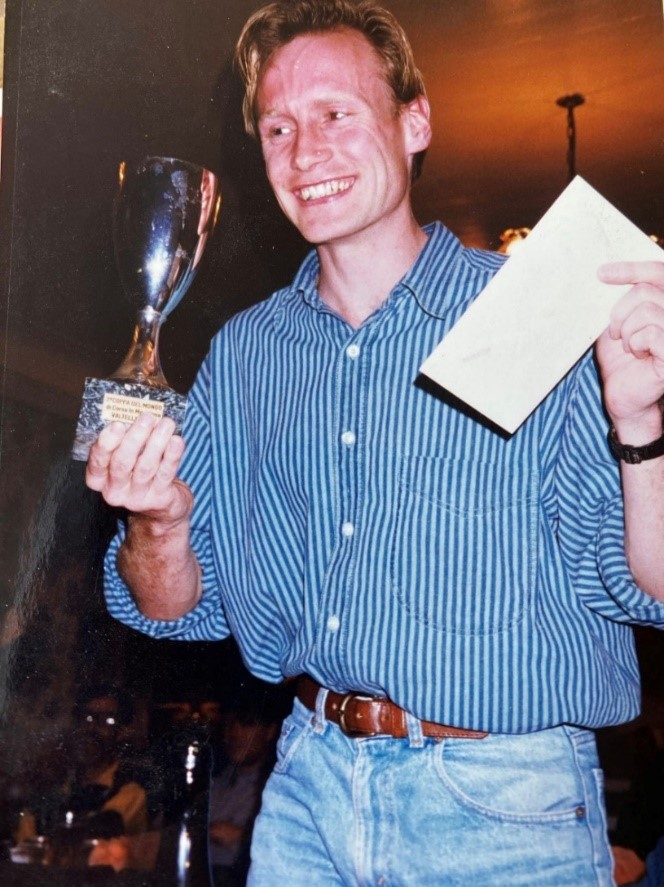
Above:Ian with Newcomer of the Year Trophy awarded by the Scottish Hill Runners Association
The report is from the Clydebank Post in September 1992 tells us that “Ian Murphy, fresh from his 10,000m race the previous week, was first in the men’s race at Glen Trool where he broke the record by the huge margin of 8 minutes in a time of one hour 17 minutes 44 seconds. To break a record by however small a margin is a major achievement but to shatter the record as he did is really exceptional.”
We should now look at just some of the races he contested to see the range of distances and quality of his running: it would be impossible to cover them all. In 1993 his most notable victory was probably when he won at Durisdeer on 28th March in 1:34:06, and on 7th May 1994 he was third in the hotly contested Ben Lomond Hill Race against some of the best racers from both north and south of the border.
1995 was a particularly good year and started in March with a victory in the Glen Fruin race in Helensburgh. That was followed on 9th April with second place in the Four Tops which is run over 14 miles at Fort William in 2:19:53. On 20th May he won Goatfell Race in Arran in 1:18:45. Came 11th June and he won the Aonach Mhor in 1:19:10 and into August where on the 6th he was fourth in Glen Clova in 2:45:45. At the end of the season, on 19th September he was 10th in the Scottish Trials.
Ian always liked a challenge and on 31st August, 1995 he took on the Ossian Challenge. The Challenge was to run round Loch Ossian in under an hour. His friend and running ompanion Pat Bonner, no mean runner himself – describes the event: The Loch Ossian round loch challenge is just over seven miles on forest track. The challenge to complete course in under an hour was set up by Tom Rigg who was warden for 23 years. Thousands have attempted it. On that day in 1995 Ian broke what had been a record held for twelve years on 31 August 1995 with time of 38 minutes 19 seconds. Hostel warden Tom Rigg, originator of the event, held the stopwatch. That record still stands. Ian smashed existing record by over one minute which had been set by and Englishman named Bill Nock. The extract from the log listing all the runners is below with a memento in the form of a photograph.
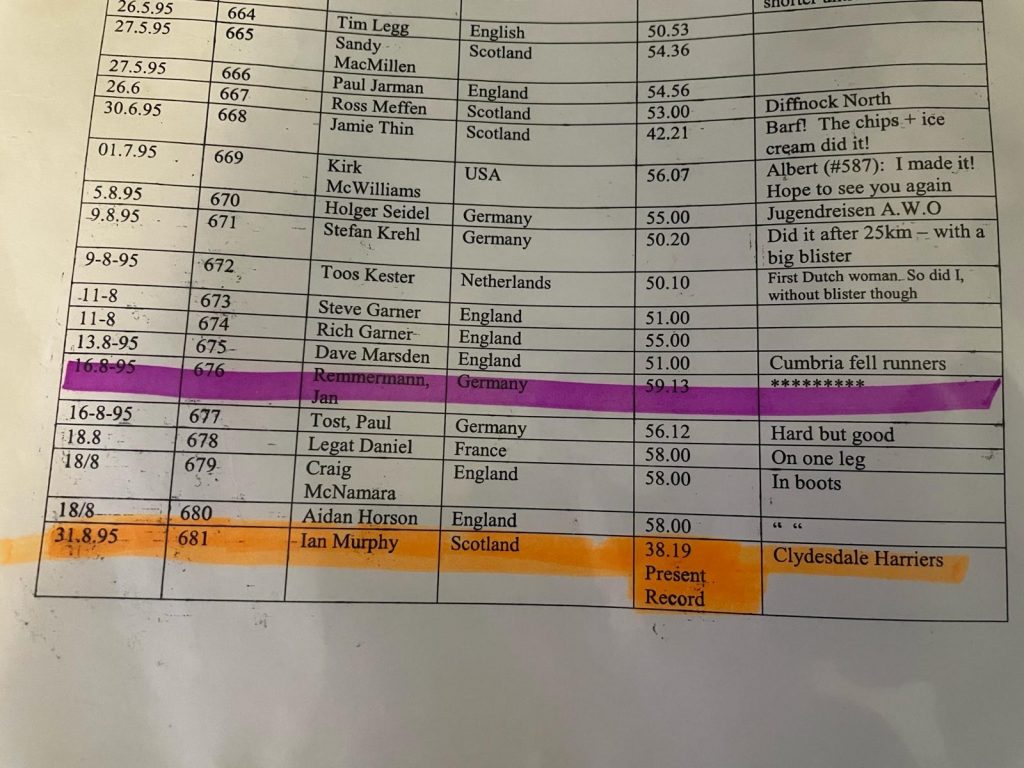
NB: Pat also completed the challenge and was comfortably within the one hour target –

It is quite a picture the story is that the deer’s name was Windswept and Tom had taught it to enter the hostel and put its front hoofs on the bench we were sitting on for the reward of a banana. It then very gracefully exited the hostel door in reverse, turning it head to get through the doorframe as it left.
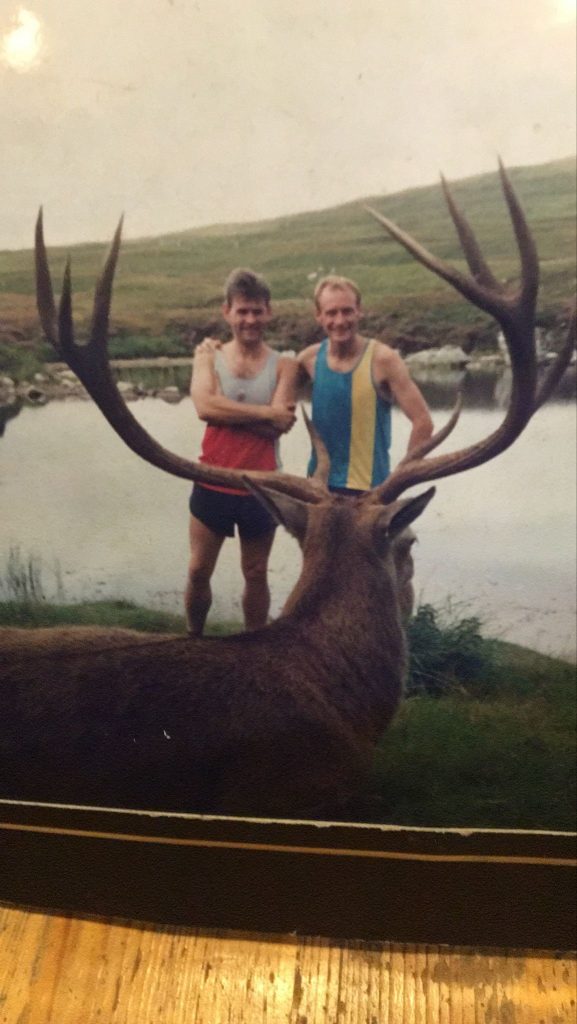
As a Firefighter, Ian competed for the Strathclyde Fire Service and did so very successfully. In January 1996 in the European Fire Services Championships, against a field of 900 runners over 10,000m in Amsterdam, he won the event for the third time in a course record of 31:01. In April he ran as a guest in the Scottish Police Championships at Tulliallan and won comfortably. In June he won the Kilpatricks Hill Race in 53:54.
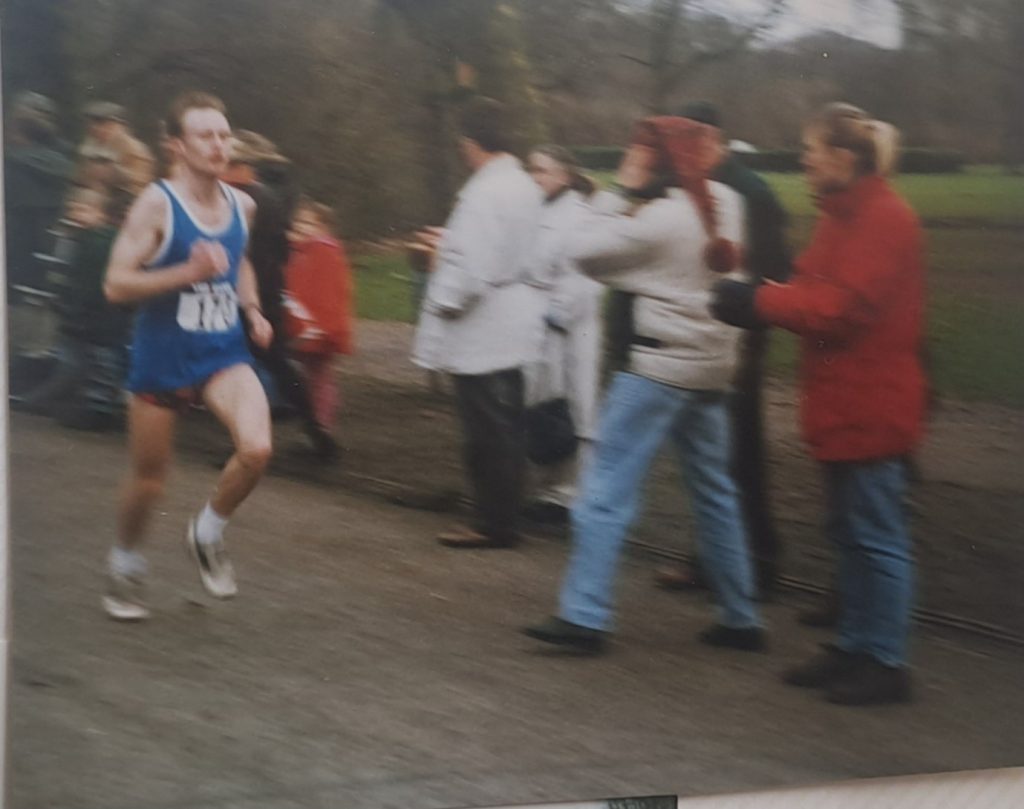
Ian running in Amsterdam in 1996
As a Firefighter, Ian competed for the Strathclyde Fire Service and did so very successfully. He joined the Fire Service in 1993 and was extremely successful in firefighters championship races in Scotland, in England and in Europe. In January 1996 in the European Fire Services Championships, against a field of 900 runners over 10,000m in Amsterdam, he won the event for the third time in a course record of 31:01. In April he ran as a guest in the Scottish Police Championships at Tulliallan and won comfortably. In June he won the Kilpatricks Hill Race in 53:54.
Ian missed almost all of 1997 through injury and illness but he did run in the Kilpatricks Hill race and win again over a new course when the organisation of the race was done by the Westerlands club from Clydesdale. His time was 44:23 – more than 2 ½ minutes ahead of second placed Adam Ward of Carnethy.
In 1998 he was third in the Criffel Hill Race in 52:40. In May he ran two Firefighters races in seven days. First there was the Fire Services relay in Strathclyde Park where he had the fastest time of the day in a course record, and then a week later he was second in the International Fire Fighters 10K Championships at Lochinch. Only beaten by a single second it was his first ever defeat in a Firefighters race. Nearer home the County Cross-Country Relay Championship was held over the rugged and hilly Braidfield Farm course. James Austin gave the club a lead on the first stage, Allan Adams increased it on the second, Ian increased it even further and Billy Jenkins on the last stage went off the trail but still won – this led to an appeal by Victoria Park on the bizarre grounds that he had run too far!
Ian started 1999 with a victory in the Dunbartonshire County Cross-Country Championships at Strathleven, Dumbarton in 36:23 from Stuart Kerr (Kirkintilloch) and English internationalist Kevin Forster (Victoria Park). Then it was back to the Glen Fruin race in April 1999 where he won for the third time by over three minutes in 77:20. Not only that he won the King of the Mountains when he was leading at the highest point of the trail. In May he won the Whangie Whizz by almost two minutes in 26:28. The came two Fire Fighters races in three days. He had the fastest time of the day in the 6 x 4 miles relay and then won the International Firefighters 10000m in Lochinch by 48 seconds from Graeme Croll in 31:40. Two thirds followed – in June he was third in the Polaroid 10K and in July in the Cort-ma-law over 6 miles in 48:50 (34 seconds behind the winner) before winning the Half Ben Nevis race (6 miles, 2200 feet of ascent) . His running so far in 1989 led to his selection for the Snowdon International Fell Race where he was twenty second. Then, possibly the most remarkable of them all, he ran in the Glasgow to Fort William race over 90 miles and finished second in 18 hours and 20 minutes, a time only 30 seconds behind the winner: ie less than 200 yards. He always liked the longer distance but this one was even longer than anything attempted so far. It ended a quite remarkable month’s running. Nevertheless, he was back in the event in 2003 when he was third in 17:55:25.
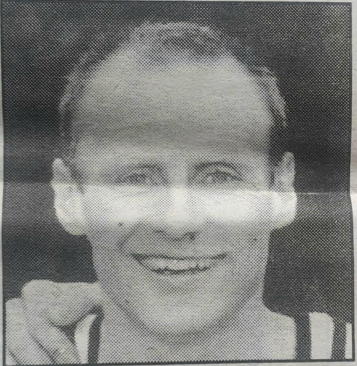
A note on the Edinburgh to Glasgow Road Relay later that year (November) – Ian was on the tough sixth stage over 7 miles but he had come straight off shift and went straight through to the Forestfield Inn which was the starting point of his stage!
Ian was a good club man who competed for the club on road, track and country. He was a real talent and when in the mood, few could live with him. Both were put into words when he was asked to run in a Scottish Track League 10,000m race for the first time. He asked who were the best runners in the race and when the two men from Falkirk were pointed out to him he said that he would just follow them. After 600 metres had been covered he surged to the front and ran away from the field. When the two runners mentioned realised how far away he was and how fast he was running, they gave chase but it was too late. When asked after the event why he had gone to the front so early, he said, “I don’t mind getting beat, but I wasn’t going to get beat at that pace!” Some stats from top competitions. In the National Cross-Country Championships he ran in four consecutive years. See below.
| Year |
Position |
Size of Field |
Team |
| 1992/93 |
58th |
604 |
14th |
| 1993/94 |
51st |
541 |
13th |
| 1994/95 |
20th |
580 |
18th |
| 1995/96 |
42nd |
488 |
7th |
Cross-country racing is run on different sorts of courses and in all weathers and in the National against the top runners from Scotland whether they live and compete in Scotland or England, Ireland or Wales. He ran in the District Championships five times with results as shown below.
| Year |
Position |
Size of Field |
Team |
| 1993/94 |
8th |
c200 |
3rd |
| 1994/95 |
5th |
c200 |
5th |
| 1995/96 |
5th |
c200 |
4th |
| 1996/97 |
4th |
218 |
3rd |
| 1998/99 |
7th |
189 |
6th |
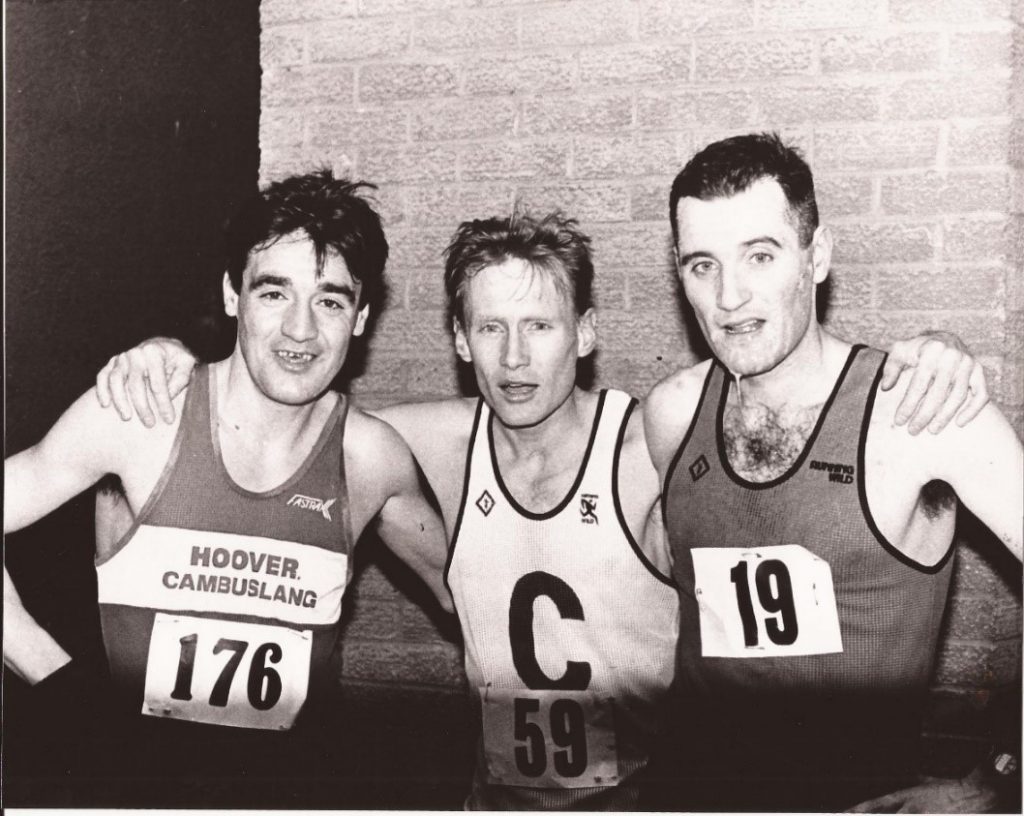
Ian as winner of one of many road races
On the roads Ian was equally effective and consistent. The most important road relay of the year was the Edinburgh to Glasgow eight stage event and held every November. Only the top 20 Scottish clubs were invited to take part and by common consent the most difficult stages were the two longest – the second and the sixth.
Ian ran in four such relays and always on the sixth. His record is in the table below.
| Year |
Stage Run |
Performance |
Comment |
| 1994/95 |
Six |
Held 8th Place |
5th fastest on stage |
| 1995/96 |
Six |
9th up to 7th |
5th fastest on stage |
| 1996/97 |
Six |
Down – 3rd to 5th |
5th |
| 1999/2000 |
Six |
19th up to 18th |
– |
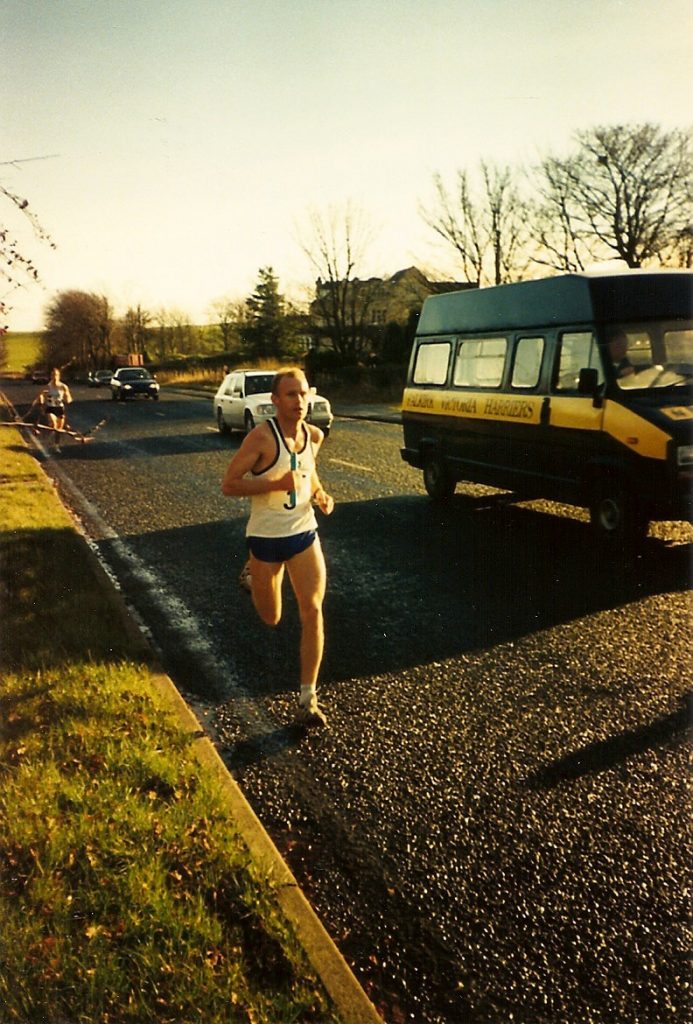
Ian on the Sixth Stage of The Edinburgh to Glasgow in 1995
He also ran on the track for the club in track league matches where he specialized in 5000m and 10000m races. His best at the former was 14:46.2 in 1995 and over 10000 he ran 31:24.0 in 1992 and 31:51.7 in 1994. The 1992 result had him placed 16th among Scottish track runners – it was achieved like all Ian’s track times in a League Match against some of the best men in the country. More important for the club was that he won almost every race he ran on the track. On one occasion when he was running in a 5000m at Grangemouth and leading the field, the English AAA’s coach for 5000/10,000m said that he looked a really wonderful runner and when told Ian was a hill racing specialist commented “That doesn’t surprise me in the least – I’ve worked with a few of these!” It would have been interesting to see him run in a championship.
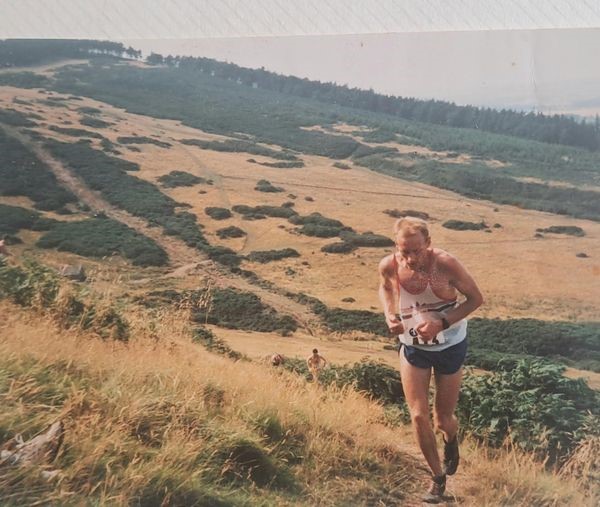
If it seems strange that a man of his talents as shown in his running and racing, and as testified by team mates and opponents alike is not better known, he just says he just didn’t want the attention; he was happy running and doing his very best.
